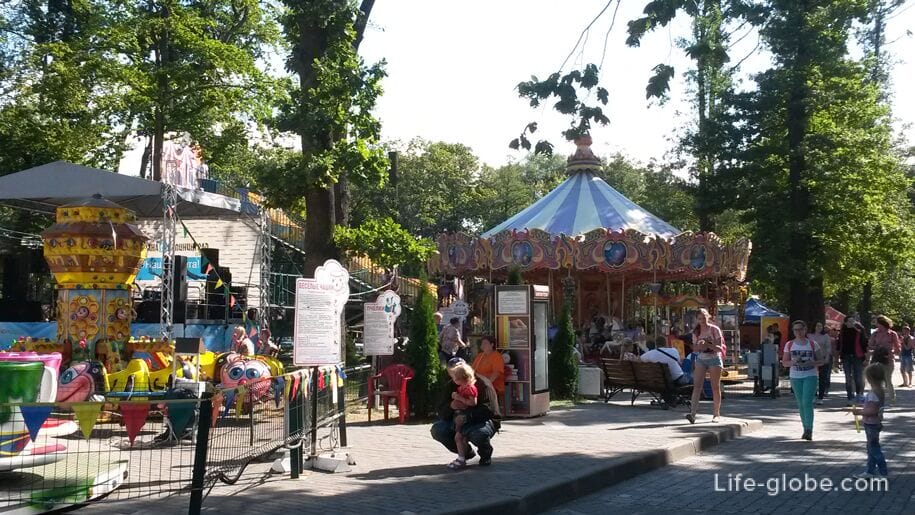
The Dona Tower in Kaliningrad is a historical fortification built in the Neo-Gothic style in 1853 on the southeastern shore of Lake Superior and named after Prussian Field Marshal Friedrich Karl Don, a participant in the liberation War of 1812 against Napoleonic France.
In terms of the tower is a ring with a diameter of 34 meters and a height of 12 meters with a courtyard and three tiers-floors, including underground.
In April 1945, during the assault on Konigsberg, the garrison of the Don Tower surrendered last, thereby marking the end of the assault on the fortress city. On April 10, the red Victory banner was hoisted on the tower. And since 1979, the only Amber museum in Russia has been located in the walls of the Don Tower, the collection of collections of which has become famous in many countries of the world.
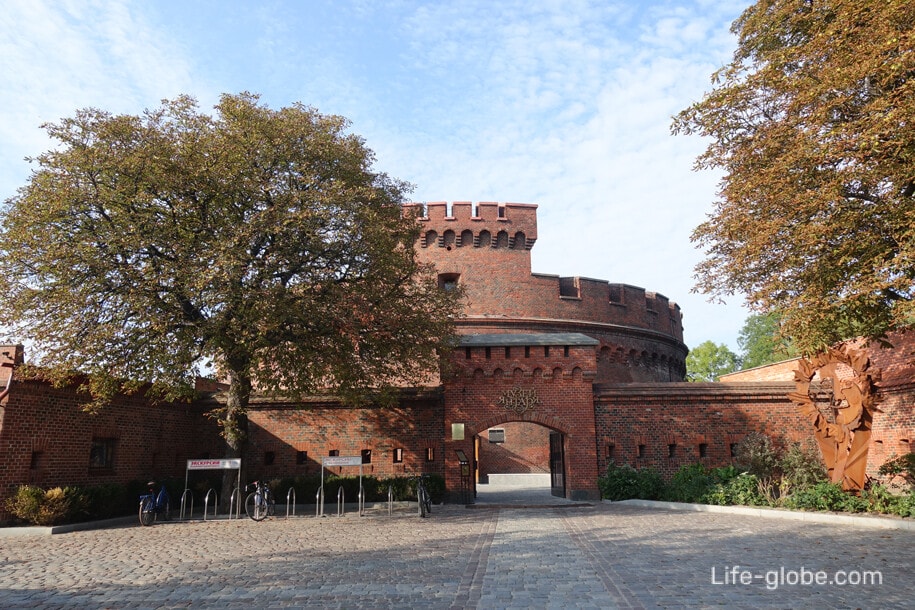
View of the Don Tower (Amber Museum) from the Upper Lake side. There are several stalls with amber goods.

Next to the Don Tower there is one of the preserved city gates of Konigsberg - the Rosgarten Gate. The tower and the gate make up a single architectural ensemble, which is simply impossible not to see while in Kaliningrad. Learn more about the Rosgarten Gate in Kaliningrad...

The creation of the Amber Museum in Kaliningrad was due to the following reasons:
- on the territory of the Kaliningrad region, in the village of Yantarny, there was and is still the largest (of the explored) amber deposit in the world;
- one of the country's leading centers for artistic processing of amber operated in the region;
- the presence of collections of natural amber and products made from it made it possible to form the museum's exposition.
Currently , the Amber Museum consists of:
- four halls, in two of which there are permanent, and in the other two - temporary (rotating) expositions. Also, one of the halls is located in the underground floor of the Don Tower;
- the inner courtyard;
- several retail outlets with amber products, a cash register, a wardrobe, toilet rooms and office premises.
Entering the gates of the amber Museum, we find ourselves in a small courtyard near the main entrance.
There are several sculptures in the courtyard, including: the sculpture "Gauja Bird", created during the Second International Plein Air on Artistic metalworking on August 13-17, 2015 and the sculpture "Amber Hunters", created during the Second All-Russian Plein Air on artistic metalworking on September 12-14, 2014.
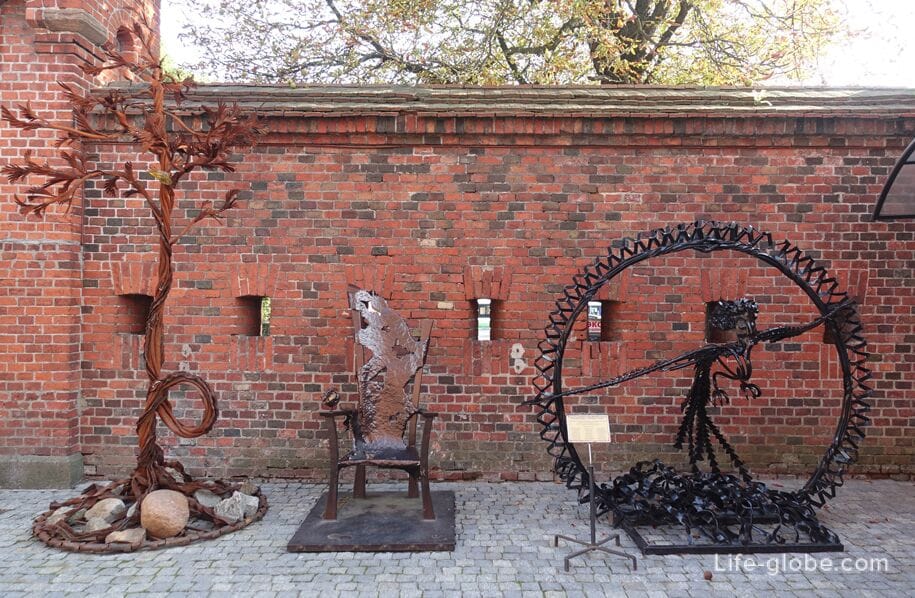
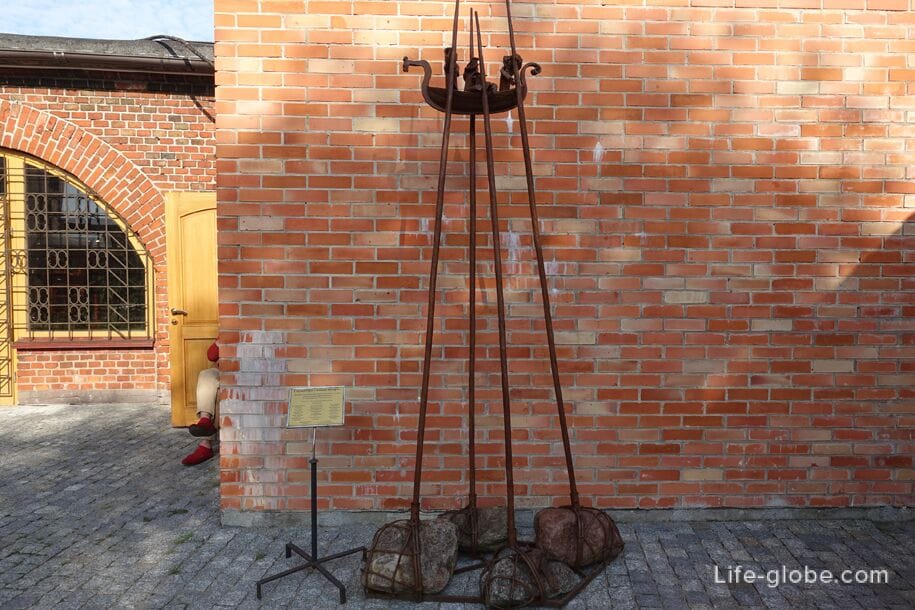
At the entrance to the amber Museum there is a small-sized sculpture - "Grandma Homlin" (Grandma Marta). The sculpture depicts the spouse of the "Grandfather Brownie", located on the Honey Bridge nearFishing villages and islands of Kant.
In total, there are several homlin sculptures in Kaliningrad, representing members of one large family - from the older generation (grandparents) to the smallest ones, which are installed in iconic places of the city. Learn more about all the homelins in Kaliningrad...
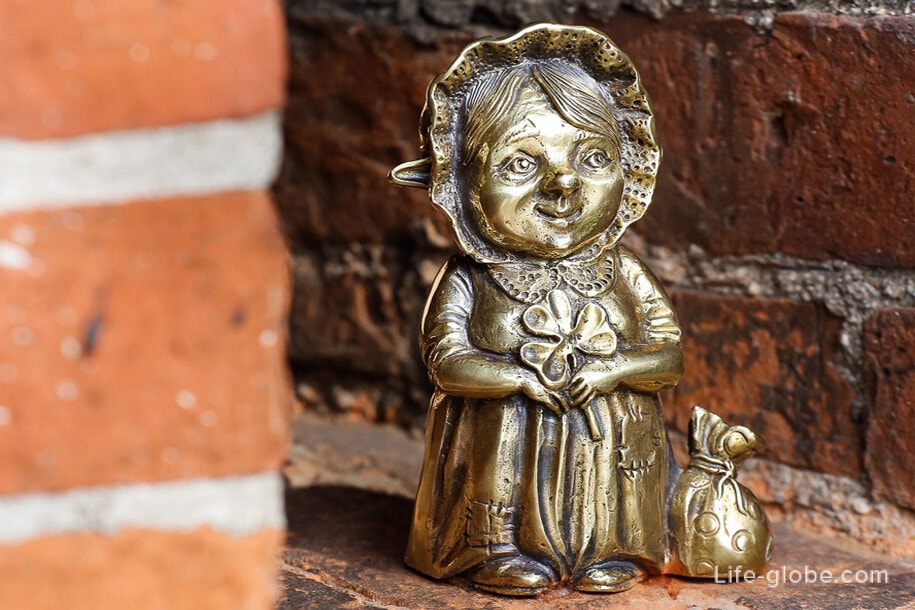
After going to the central entrance of the amber museum, we get into the hall. There is a ticket office where you can buy tickets to the museum, toilets, wardrobe and shop windows for the sale of souvenirs, jewelry and other products made of amber and with amber.
You can visit the amber Museum as part of an excursion group, or by making an independent tour of the museum halls.
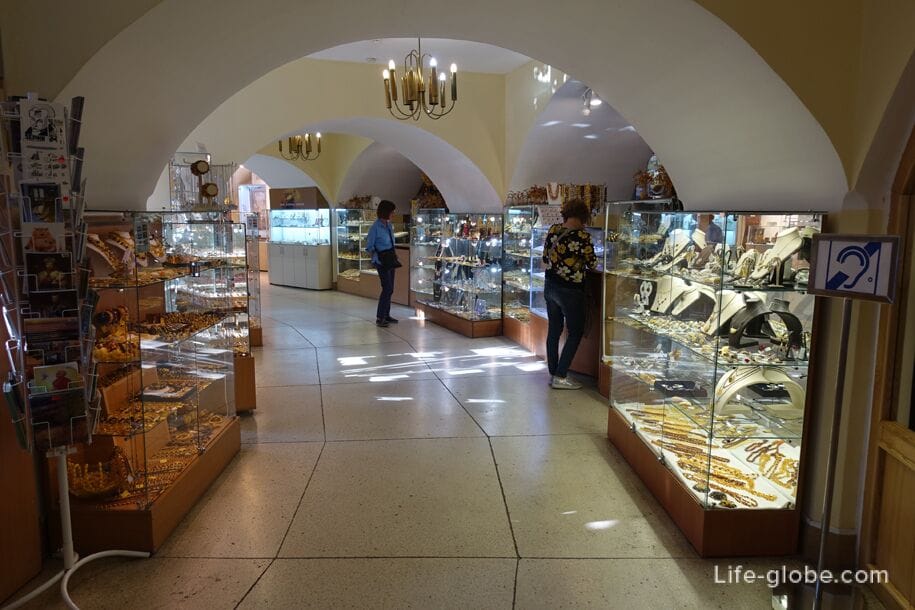
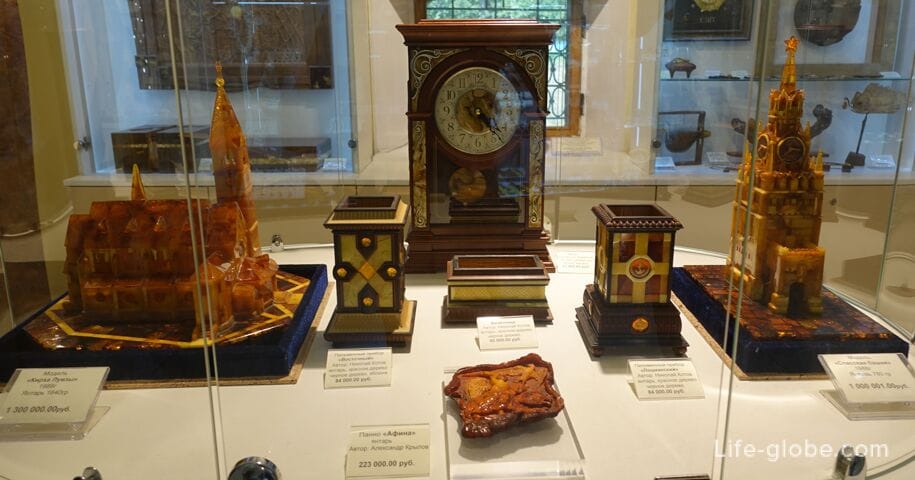

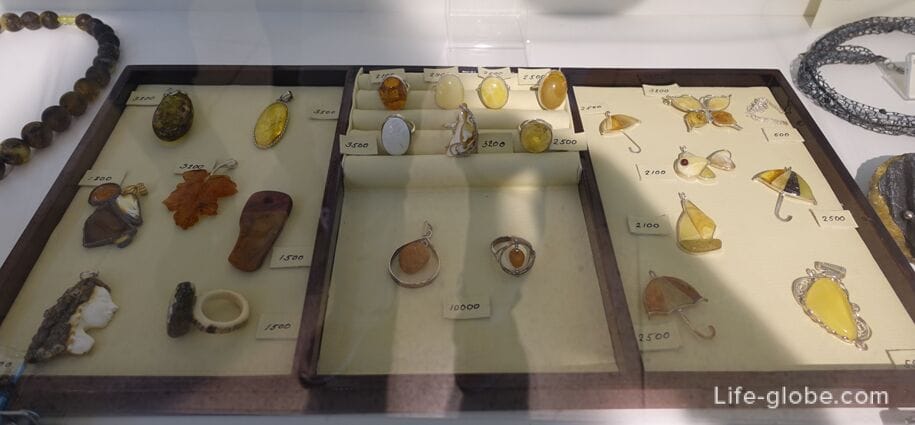
Sculpture "Prussia" ("Reconciliation"), 2013

Sculptural composition "Iron tree". "Iron tree" is an old tradition that exists in Europe. The shape of the "tree" has the form V or Y. There is not a single branch on such a "tree", it is all covered with nails.
In the Middle Ages, artisans roamed the world in search of work and exchanged their skills with their brethren. Traveling to different camps, they purposefully went to the center of a city or village to find an "iron tree" there, which served as a place of gathering and communication. Each nail driven into the "tree" represented a blacksmith, who testified with a special mark, on the one hand, that he had passed and lived here, and, on the other, reported that he was alive. It was a kind of universal language that anyone could use. A nail driven into the "iron tree" made it possible to indicate the age of the master and inform about his route so that he could be found. Such seemingly simple messages were well identifiable at first glance.
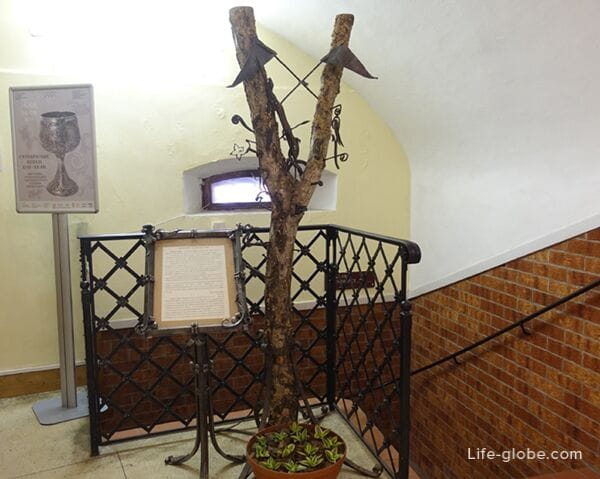
Located on the second floor of the Don Tower, the first hall of the amber Museum with a permanent exhibition tells about the origin and history of amber, amber in the culture of different nationalities, the stages of collecting and processing amber, the composition and properties of amber, amber products of the Soviet and Russian periods, objects of worship, everyday life, jewelry and other amber products, ranging from the simplest to exclusive.
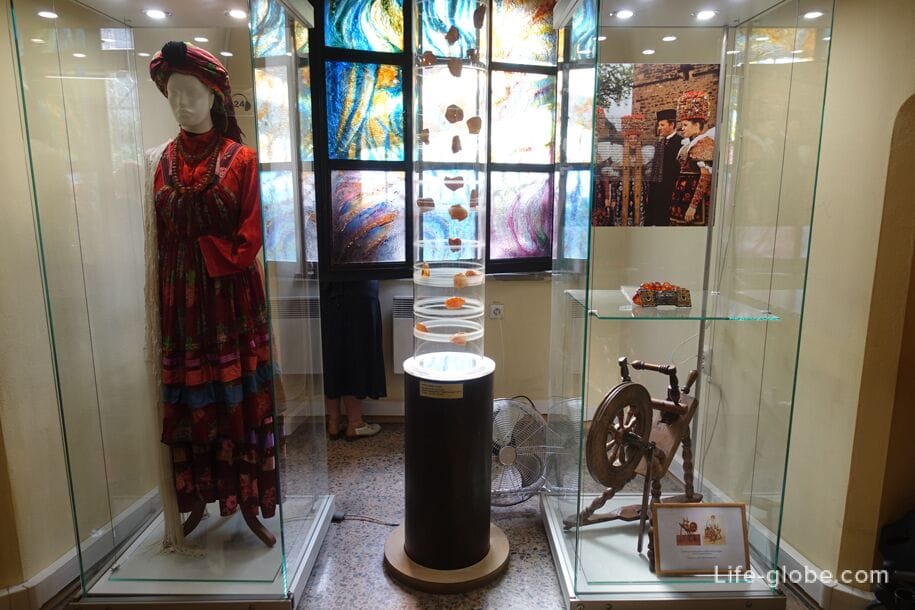
The showcases feature various forms of raw and processed amber, as well as its color scheme.

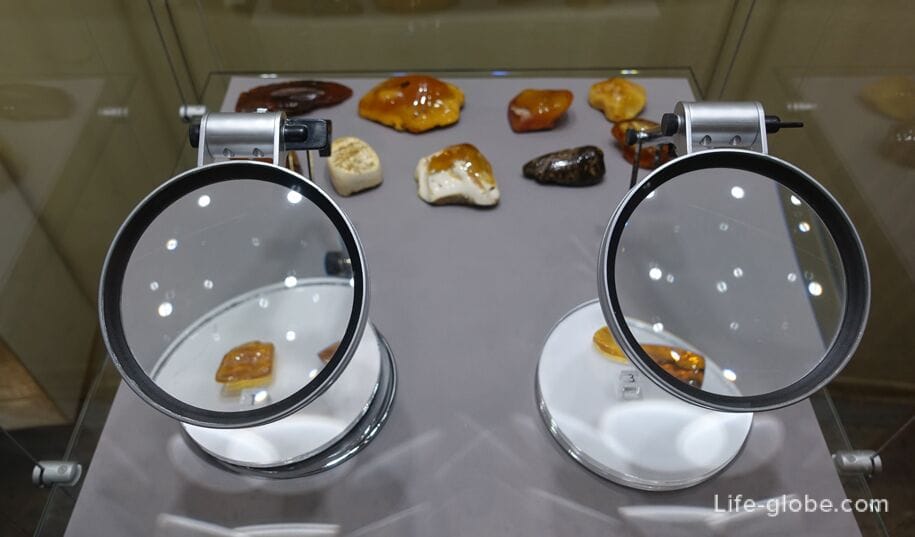
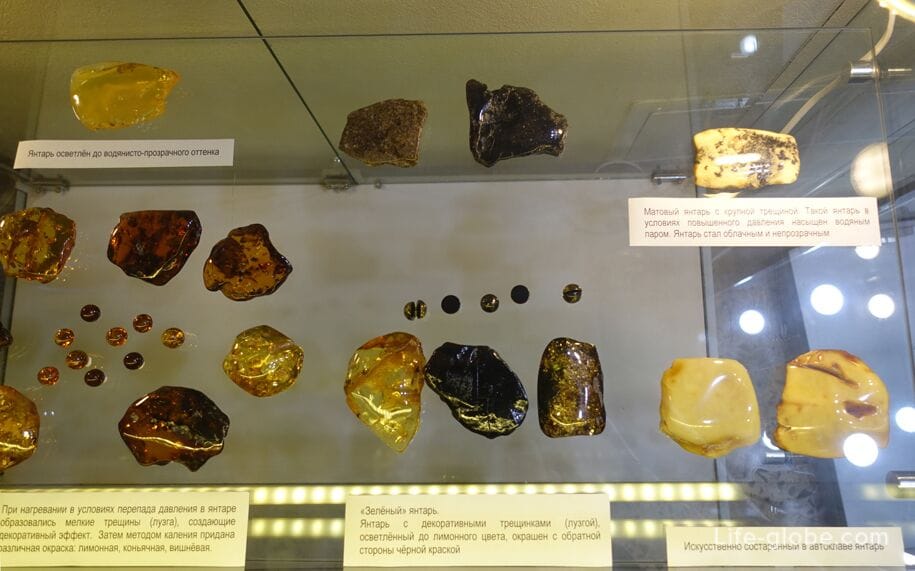
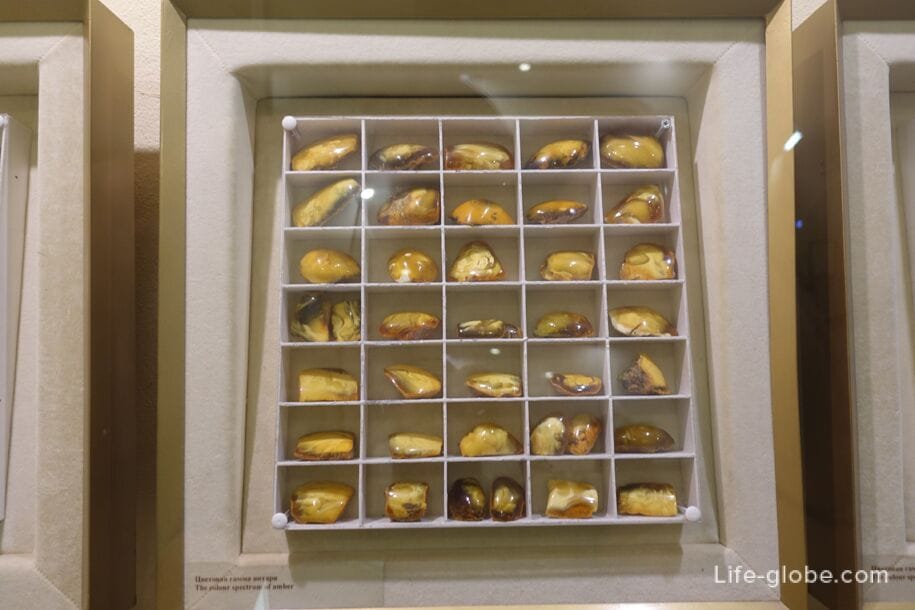
Amber according to the degree of transparency: transparent, bastard, bone and foamy
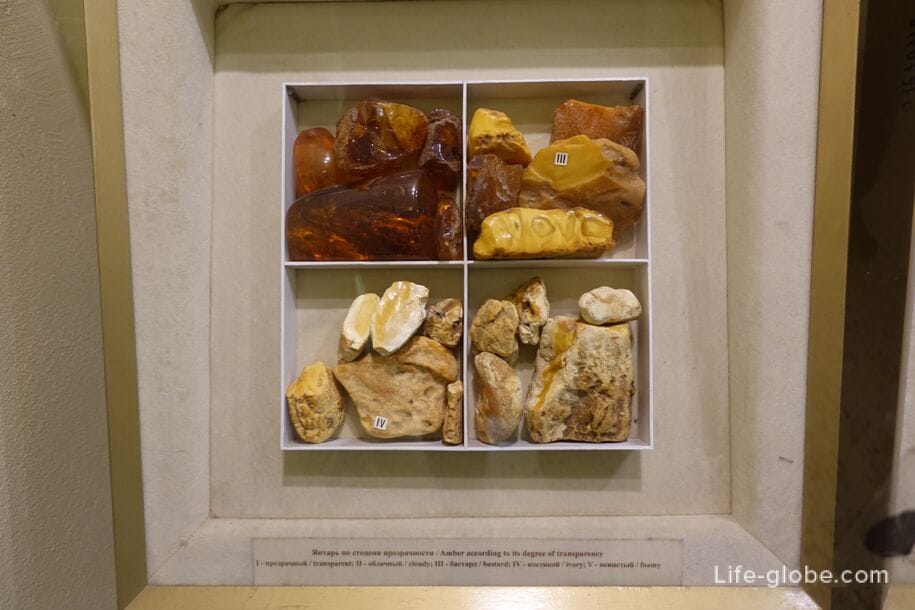
Exhibit Copal, Dominican Republic, weight - 1380 grams

Amber - like resins
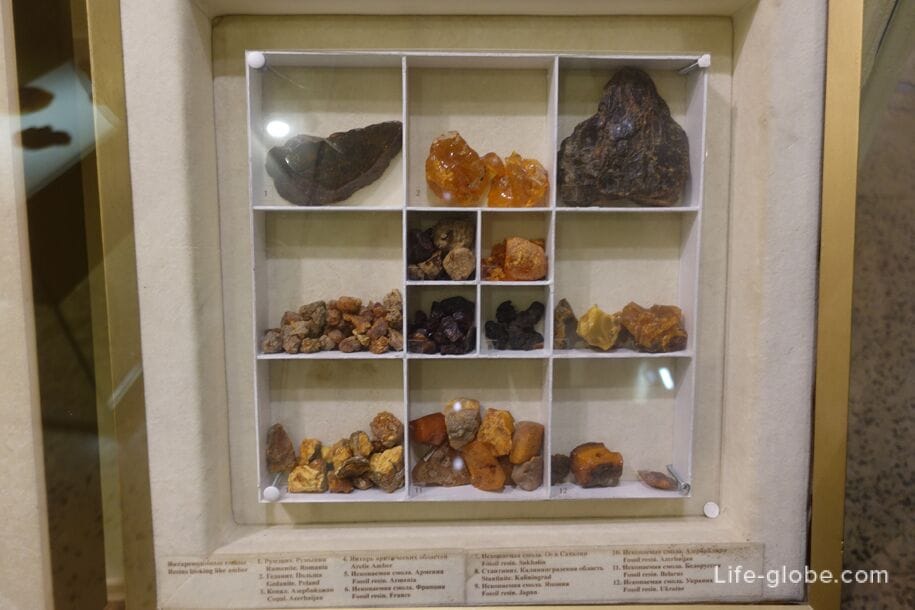
A unique sample of amber, weighing 4 kilograms 280 grams

Another unique sample of amber weighing 3 kilograms

Formation of amber. Holes in the stones are places where there were tree branches.
Amber with a small amber inside is a unique amber formation. A small hollow was formed in the trunk of the tree, which was filled with water. Resin was released from a crack in the bark, higher up the trunk. One of the portions of the resin hardened while floating in water, the rest of the resin mass filled the hollow, turning into amber over time. The water evaporated, and the drop remaining inside retained its specific shape.
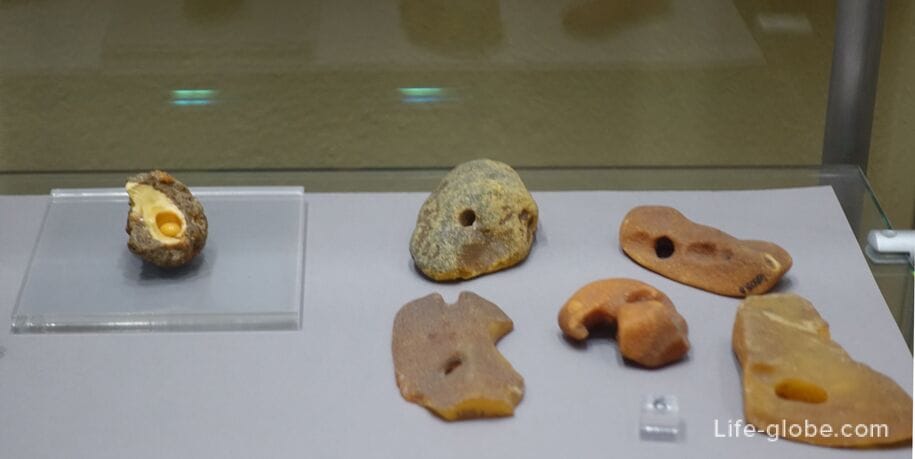
In amber, you can see the remains of animals and the remains of plants. Once the insect got into the resin, stuck with its paws and could no longer get out, remaining forever inside the rock. Such specimens are quite rare and finding them is considered luck. Accordingly, the price of products with such amber will be very high. All that variety that is sold in souvenir shops of the region for several hundred rubles is most likely a fake.

Jewelry made of amber of ancient nationalities. Here you can also see objects made of metal. Previously, amber was exchanged for other things and breeds that did not exist in this area.
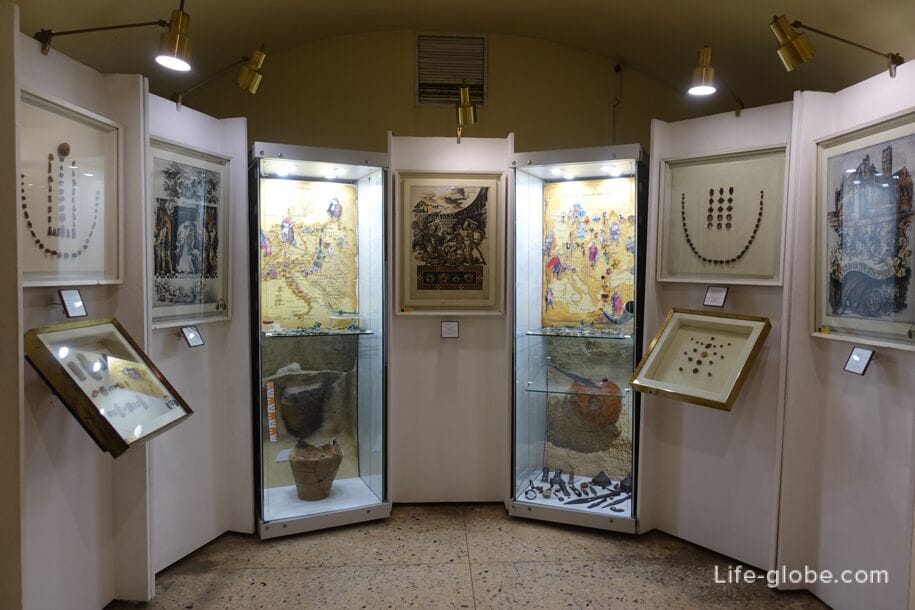
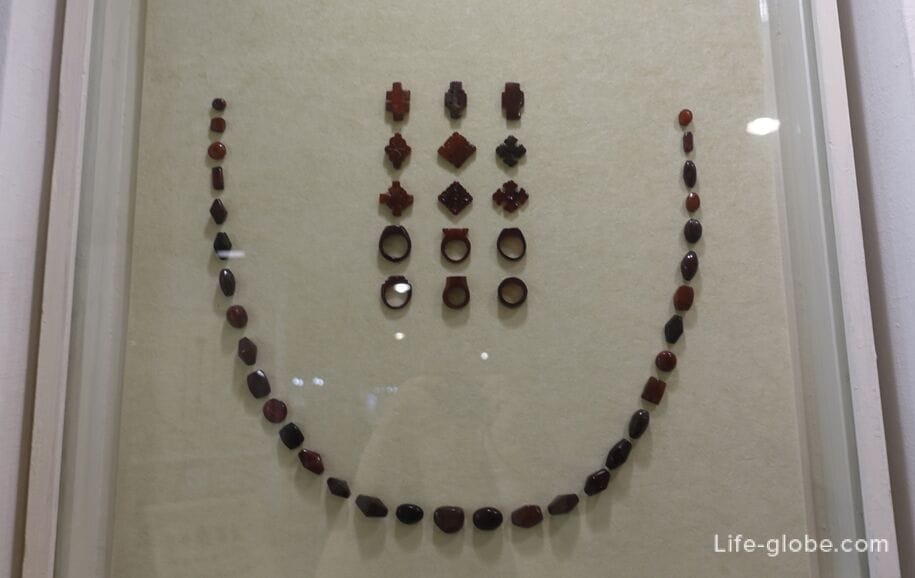
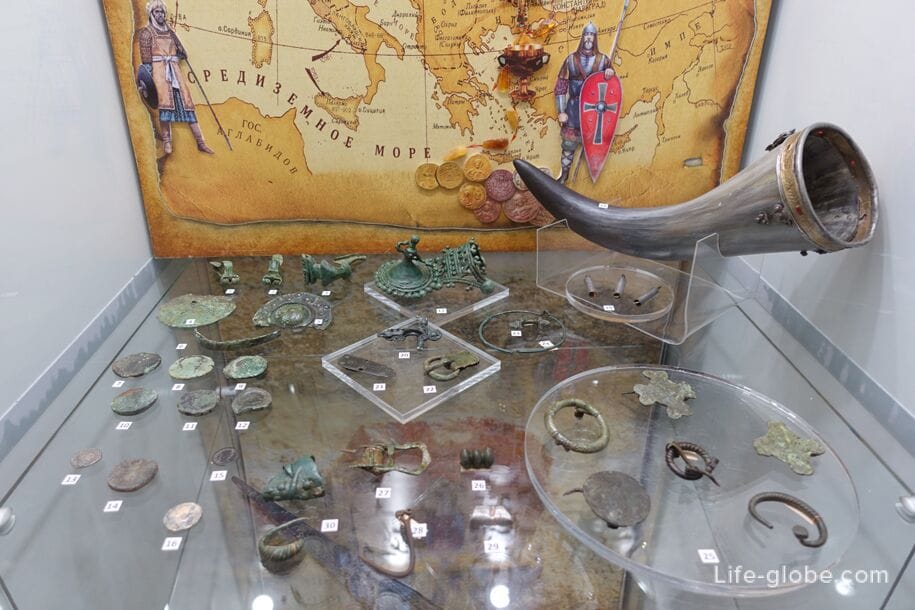
Amber trade routes of the 9th - early 13th centuries.

The casket. Copy. 1979. Location: Catherine Palace, Pushkin

Decorative plate. Germany, 16th century
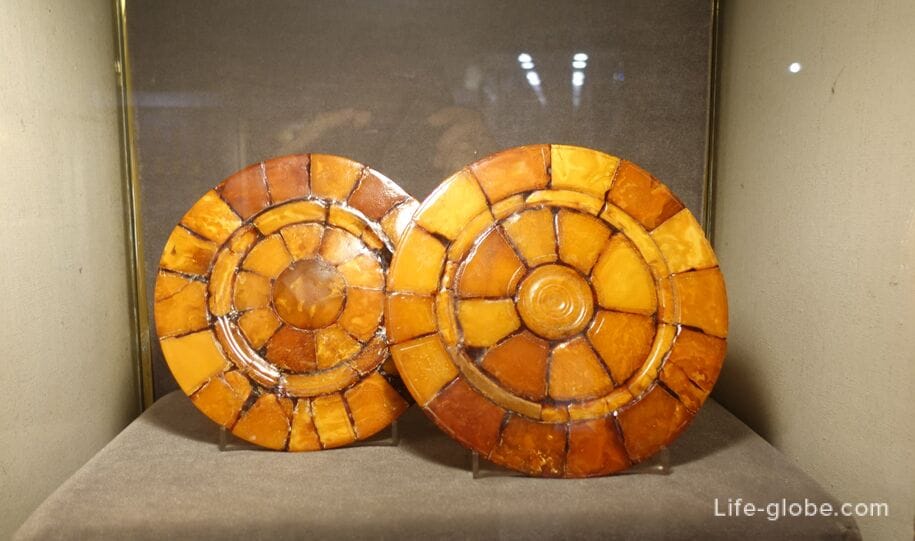
A dressing case. Copy. 1978.
Table decoration in the form of a shell. Copy. onethousandninehundredeightynine
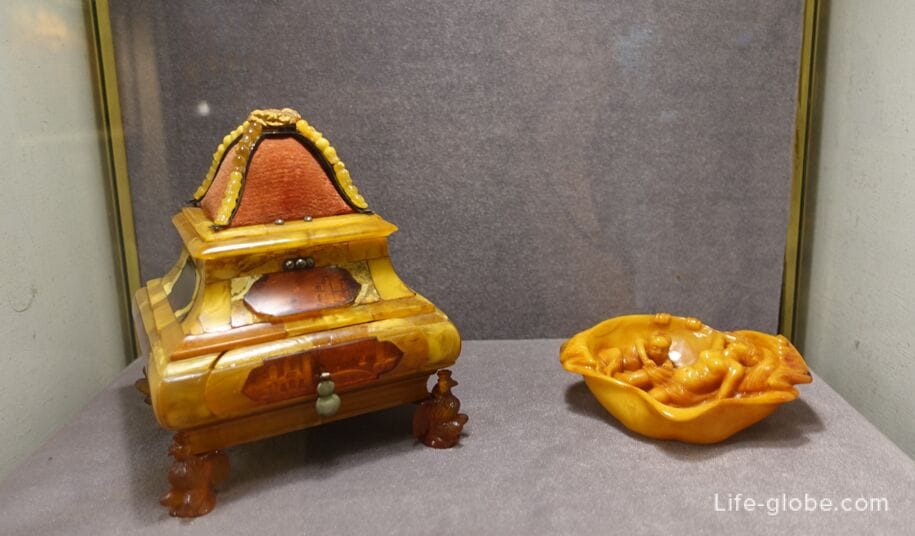
The box is two-tiered
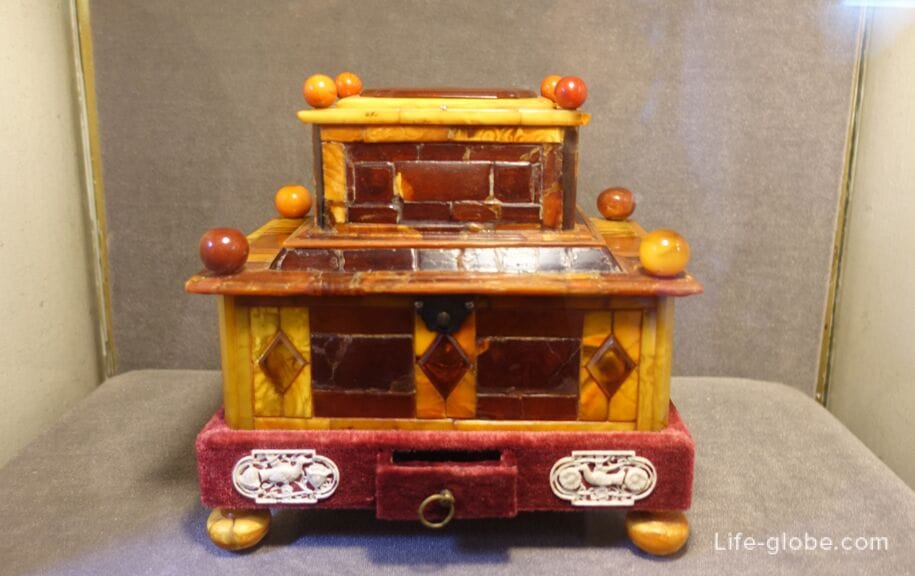
Vase "Abundance", 1954, Kaliningrad Amber Plant
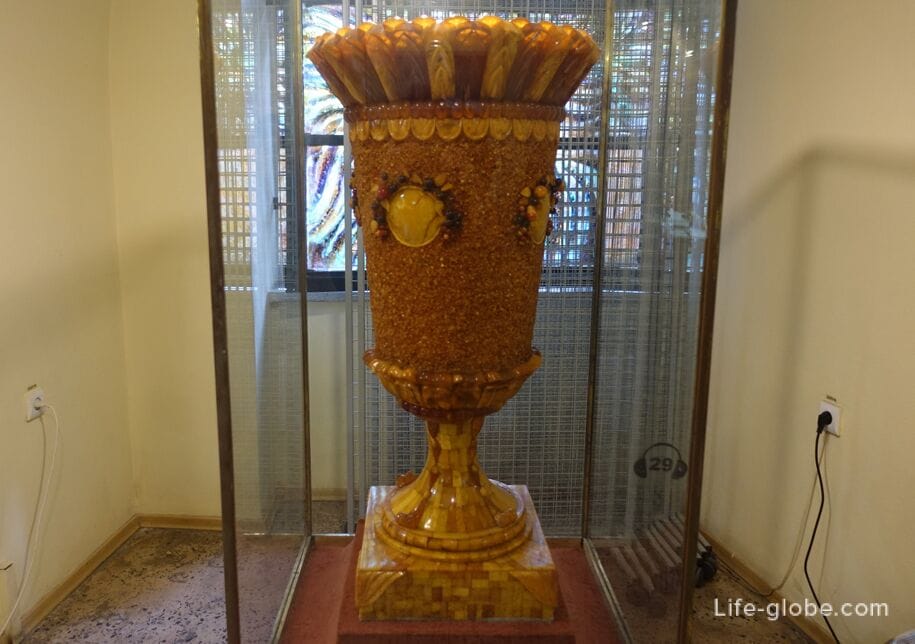
Model of the nuclear icebreaker "Lenin", 1960. The composition is made of natural amber in the mosaic technique using volumetric carving. The ice ploughed by the nuclear-powered vessel was made of white pieces of amber with a blue tint, mined in overburden rock. Amber eventually oxidized and acquired a yellowish-brown hue.
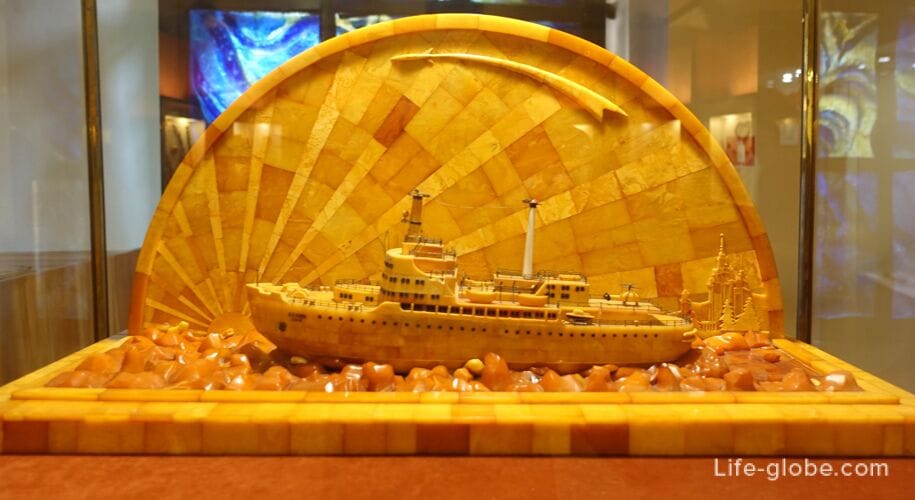
A model of the Swedish warship "Vasa" in 1628. 2007. The royal ship Vasa was one of the largest and most beautiful ships of its time, not only in Sweden, but also in Europe. Its height was 52.5 meters, length - 69 meters. The crew numbered 437 people. The ship was equipped with the latest in that naval technology. 64 bronze cannons are mounted on two gun decks.
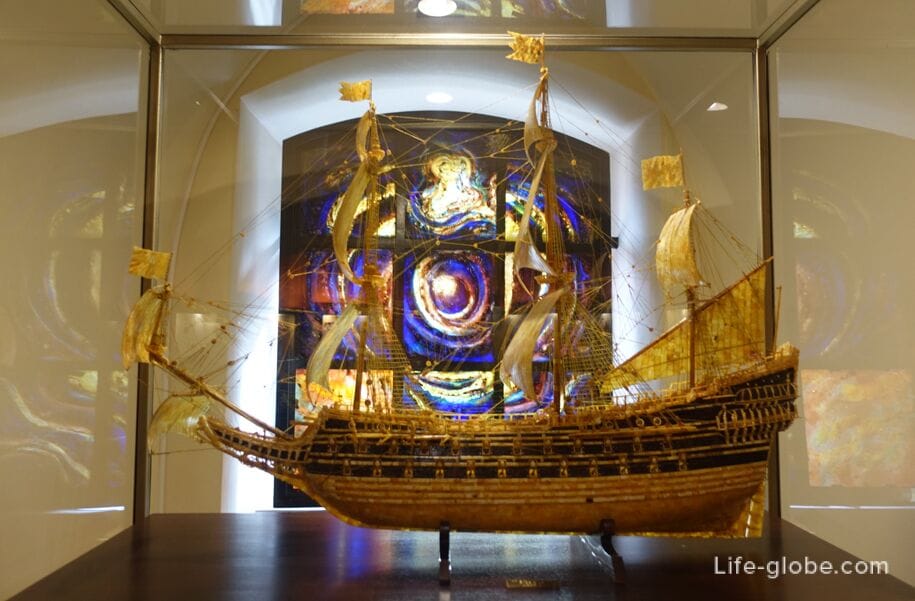
Mugs, candle holder, spoons, smoking and writing materials, jewelry, etc. All products are made of amber.
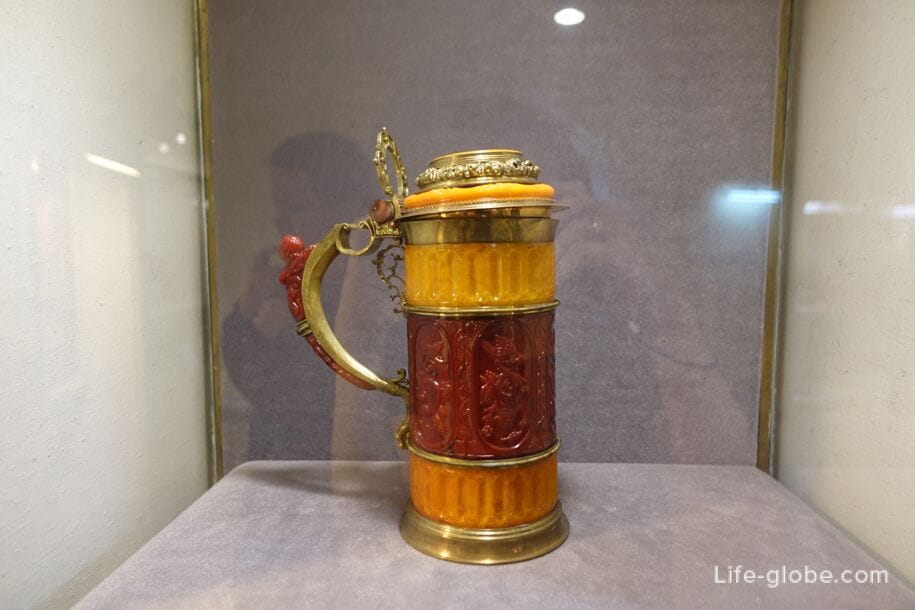
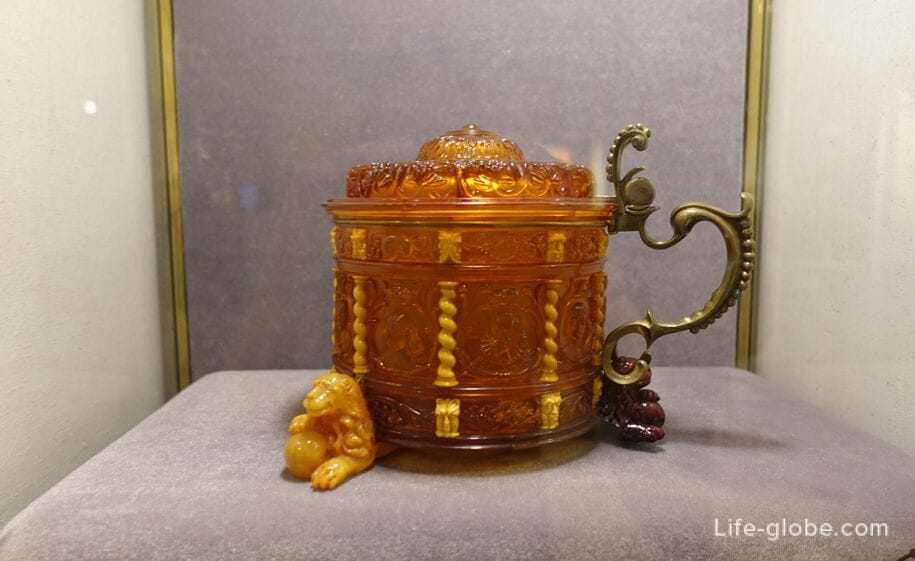
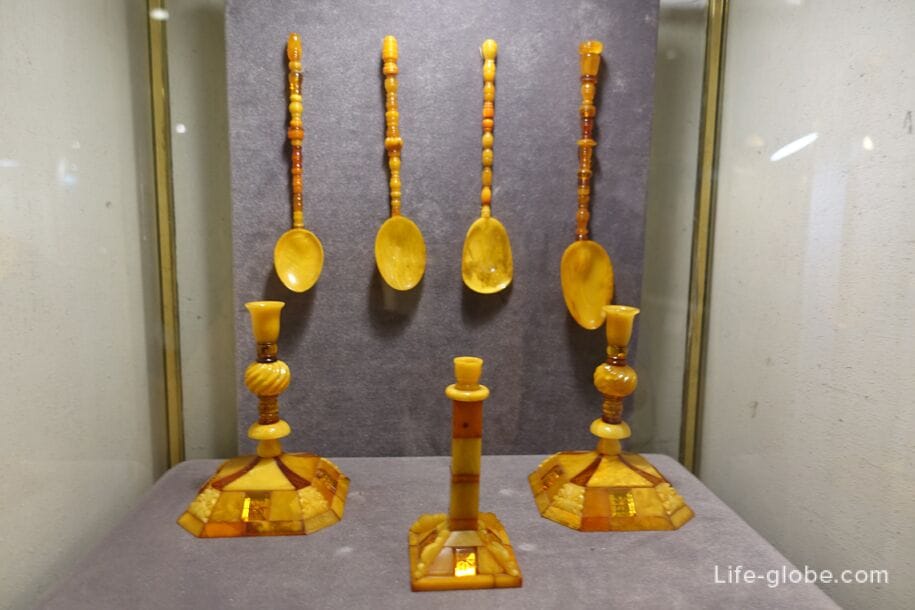

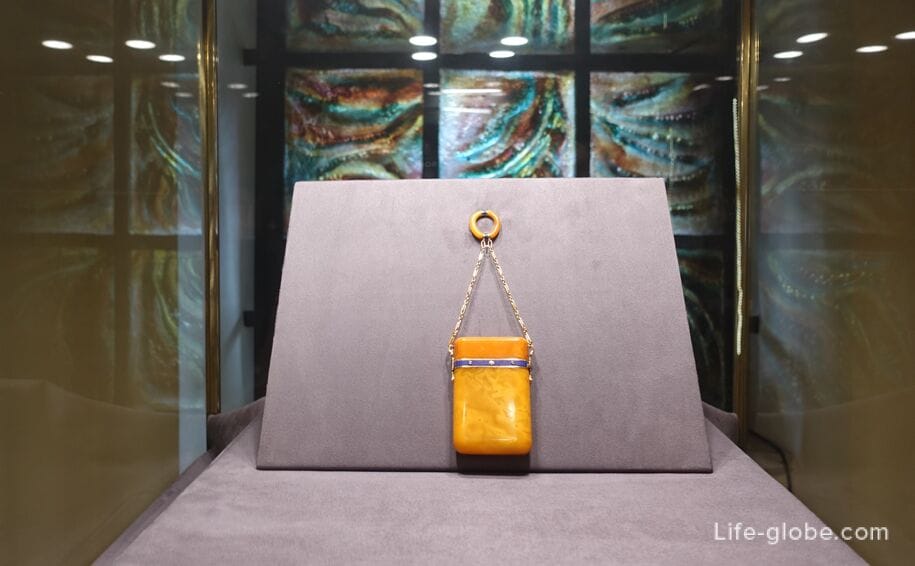
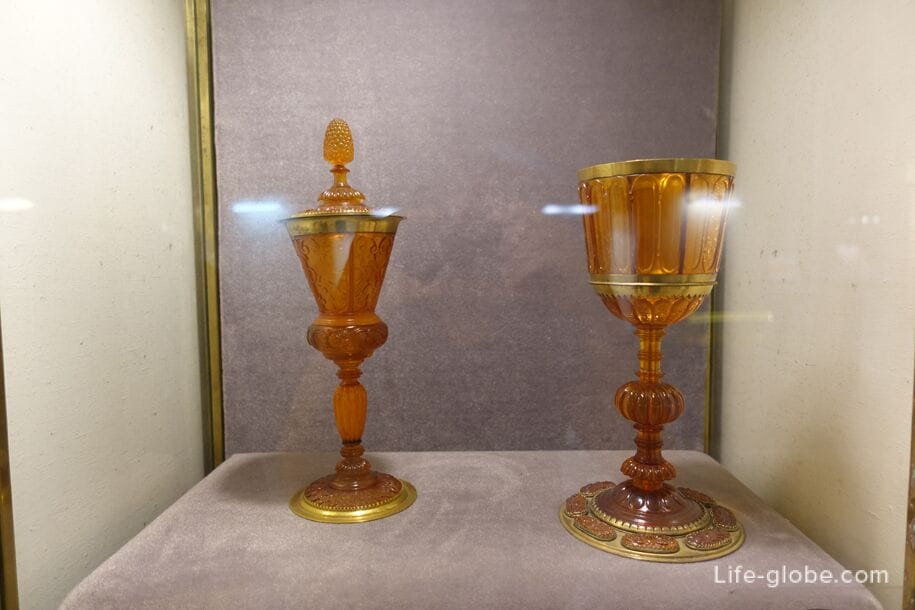

Serial production of the Kaliningrad Amber Combine, 1950-1990-ies
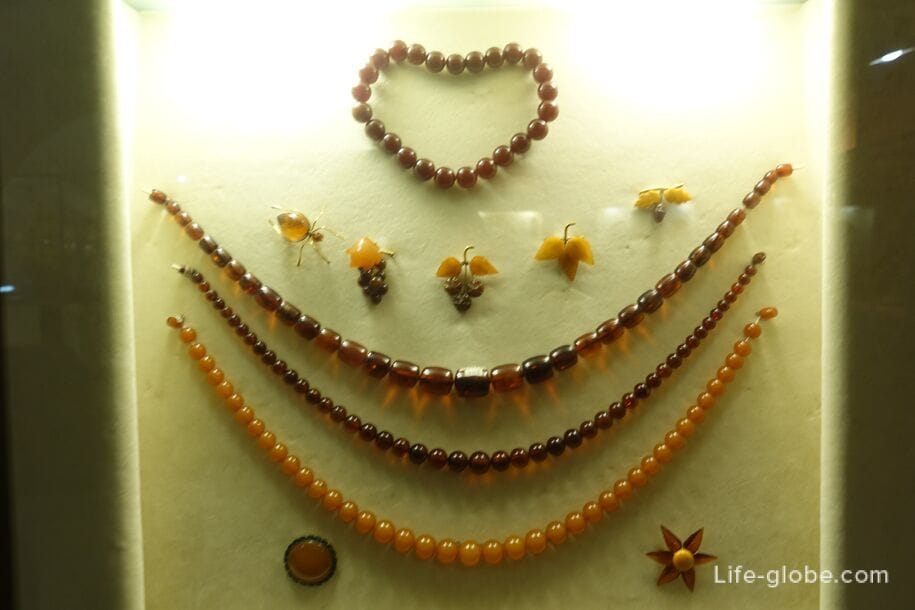

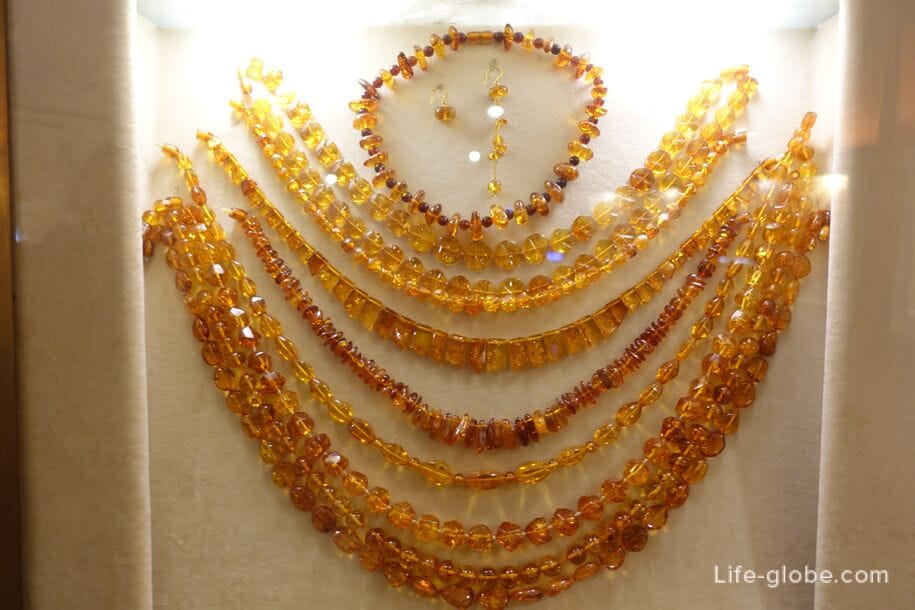
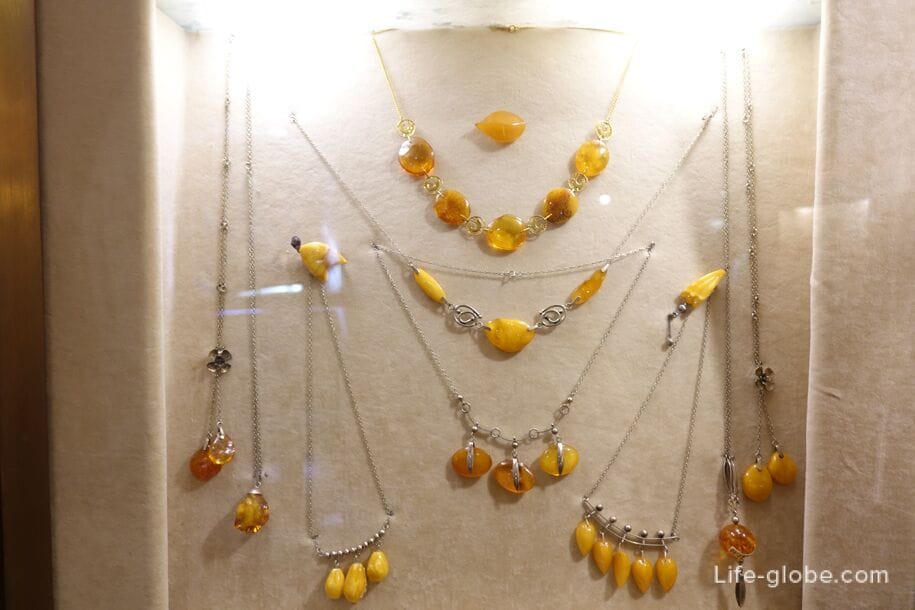
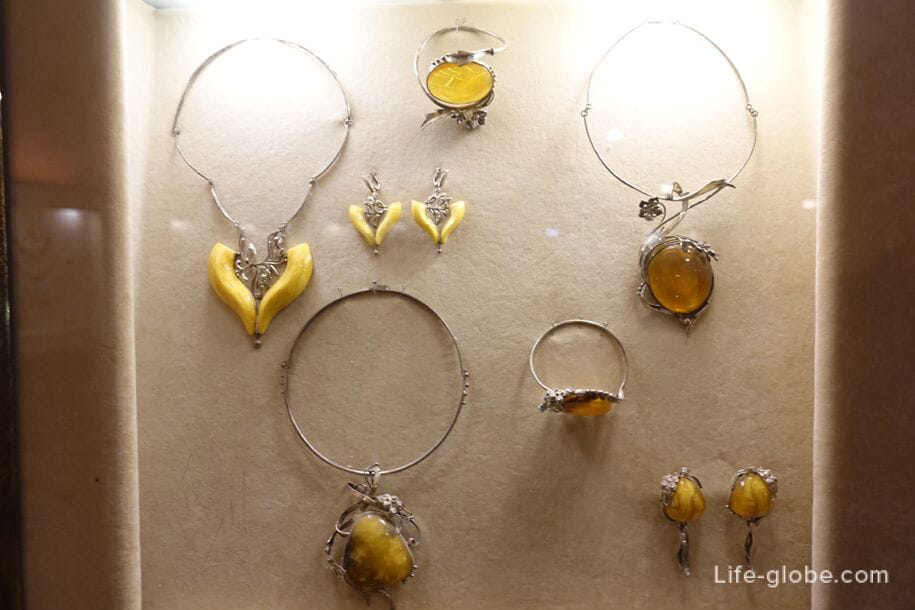
Products of the leading artists of the Kaliningrad Amber Combine 1970-2006

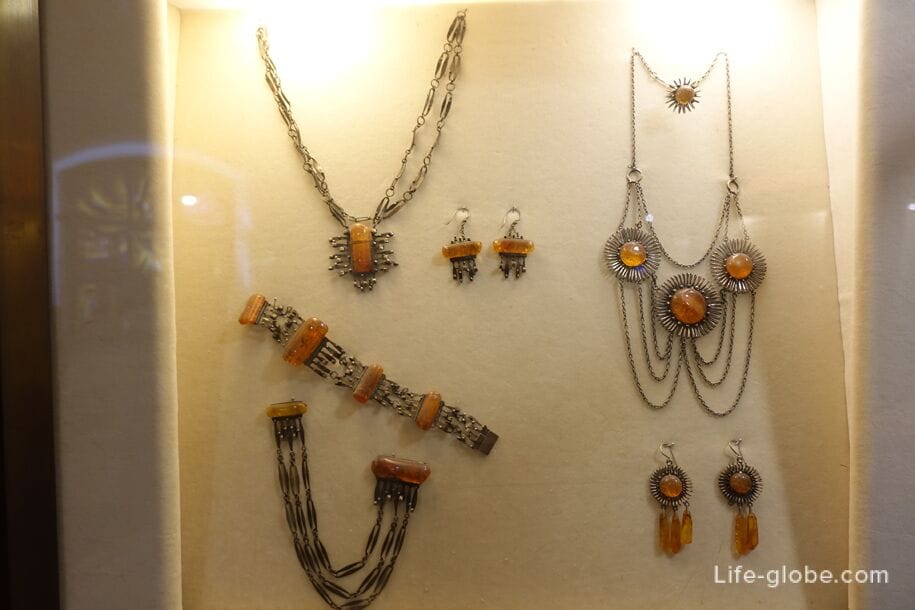

Fragments of the amber room of the Catherine Palace. Copies.
Tools for processing amber used in the reconstruction of the Amber Room (a gift from Alexander Zhuravlev).
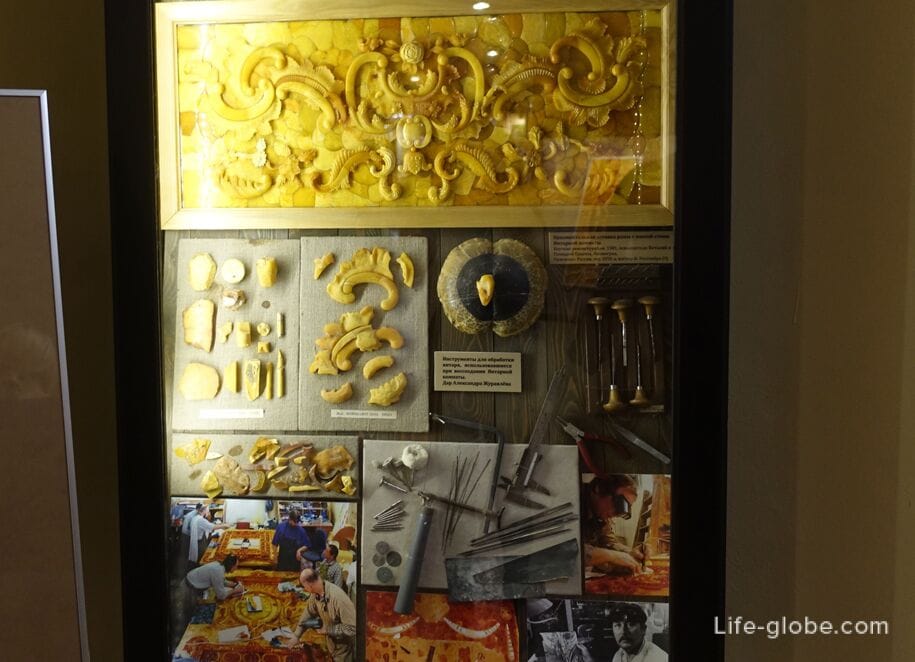
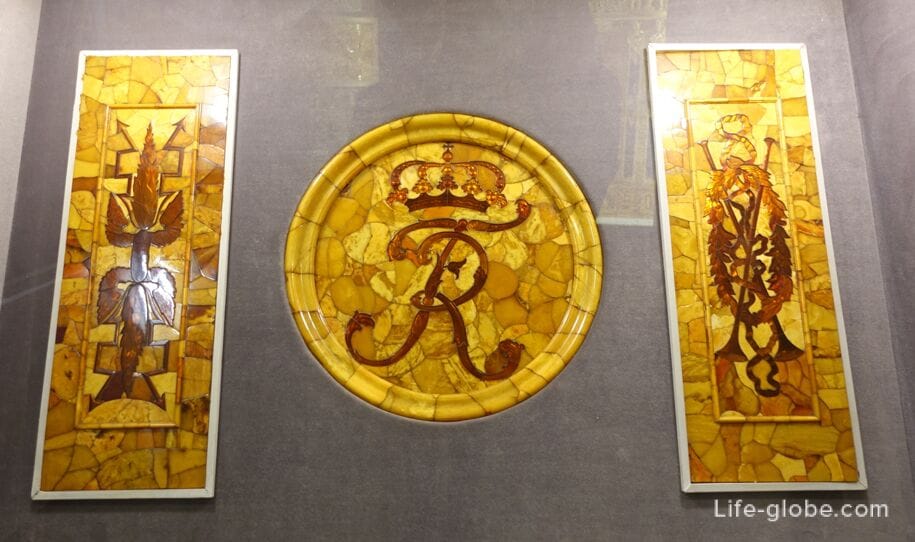
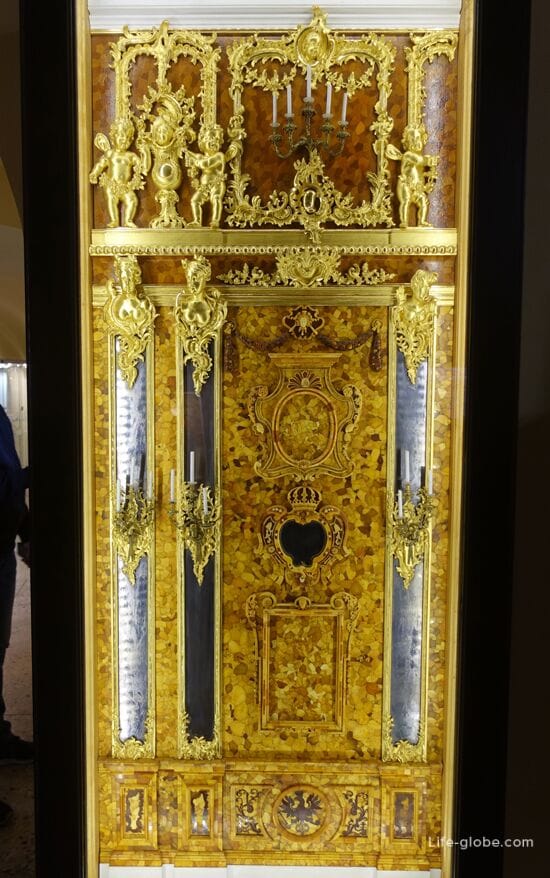
Ceremonial cap of a mining worker. The beginning of the 20th century. Germany.
Souvenir composition "Trailer with amber". The beginning of the 20th century. East Prussia.
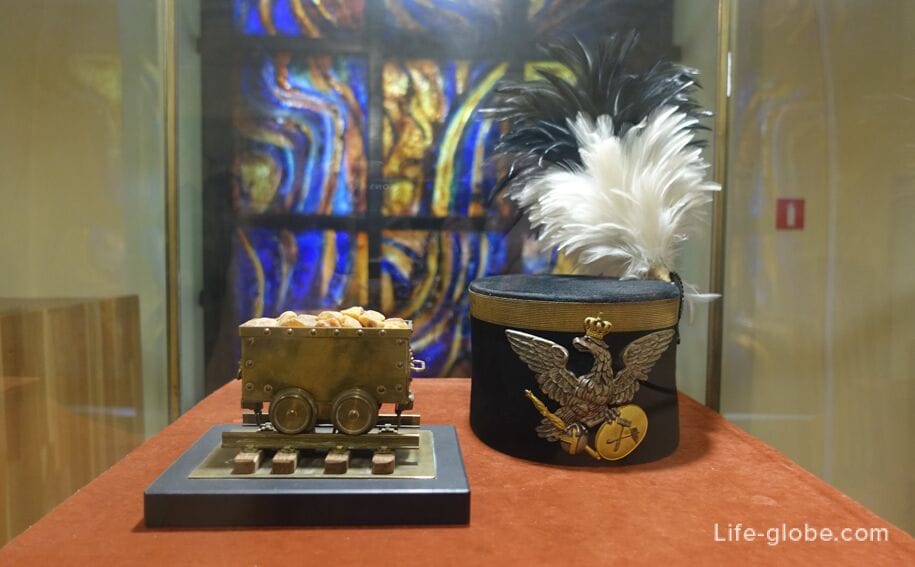
Byukeburg wedding beads. Germany. 19th century.

Images: illegal excavations near Khrabrovo, Kaliningrad region and amber hunters in the sea. Amber fishing in the Baltic Sea, especially after spring storms, is still the only legal way for residents of the Kaliningrad region to extract amber.
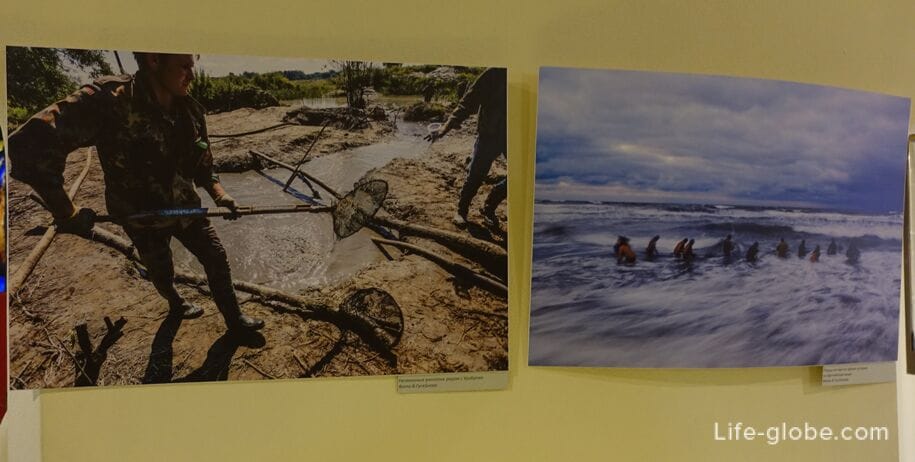
Amber-bearing rock "blue earth". Deposits containing amber are a sandy-clay rock. Most of it (up to 42%) consists of grains of a bright green mineral - glauconite, which gives the rock a greenish-blue hue, which is why it was named "blue earth".
The amber-bearing layer in the Kaliningrad region lies at different depths - from 10 meters (the village of Yantarny) to 100 meters. Sometimes the amber-bearing rock is exposed at the base of coastal cliffs. The maximum accumulation of amber in the layer reaches 4.5 kilograms per 1 m3.
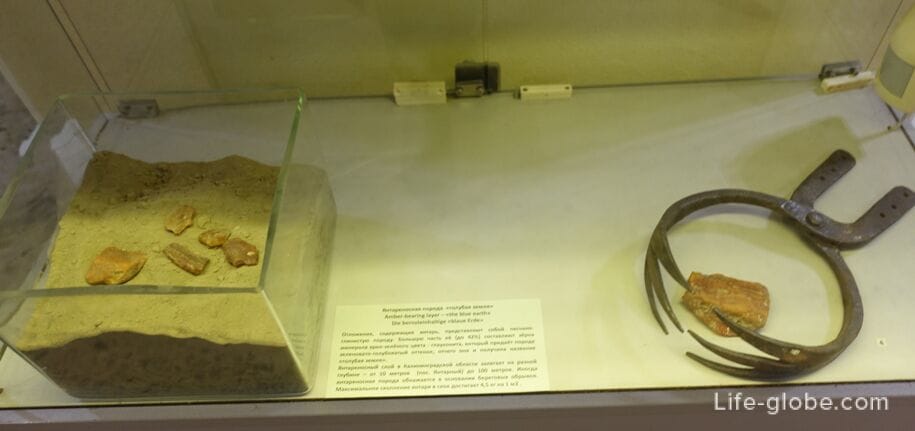
A machine for drilling holes in amber. The first half of the 20th century.

Processing and sorting factory. The erosion of the "blue earth" by hydraulic monitors. Sorted amber.
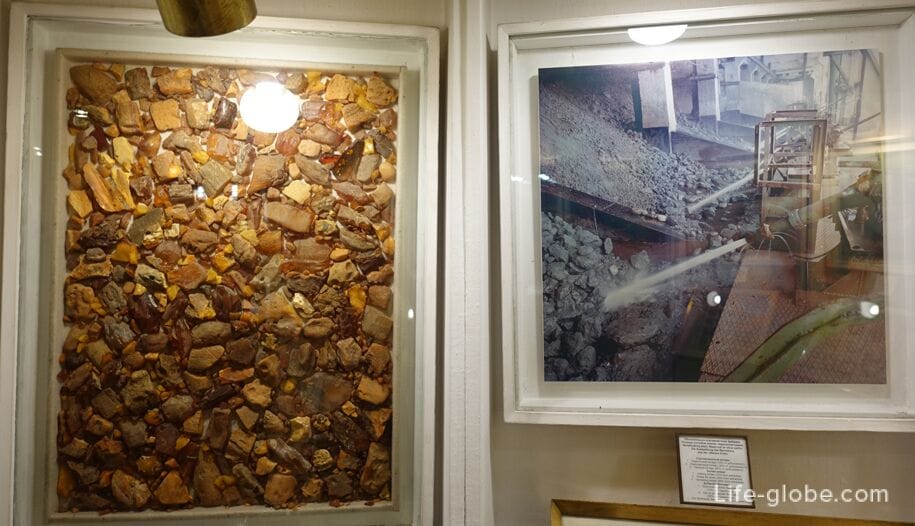
Grinding of fine amber

Amber Pines

Pressing is one of the ways of processing natural amber. Amber of small fractions is cleaned from the oxidation crust by manually sorting by color. Then the amber raw materials are loaded into a sealed working chamber, heated under pressure to the required temperature (from 130 degrees Celsius). In the process, steel molds are used to give amber various shapes: a ball, a column, a tile.

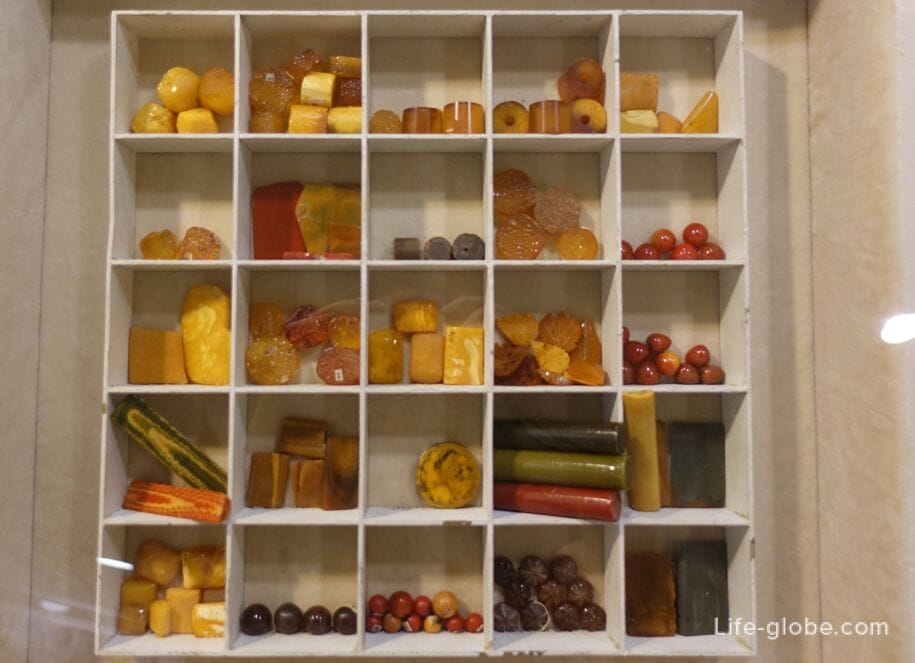

Stained glass "Manufacturer of rosaries". Amber, glass. In the design of the stained glass window, natural Baltic amber cuts are used.
The plot of the stained glass window is taken from the engraving of the same name in 1435. Rosary - "paternosters" (from the Latin "Pater noster" - "Our Father") were widespread in the 13th and 15th centuries. Most of the Baltic amber mined in the Middle Ages was used to make rosaries.
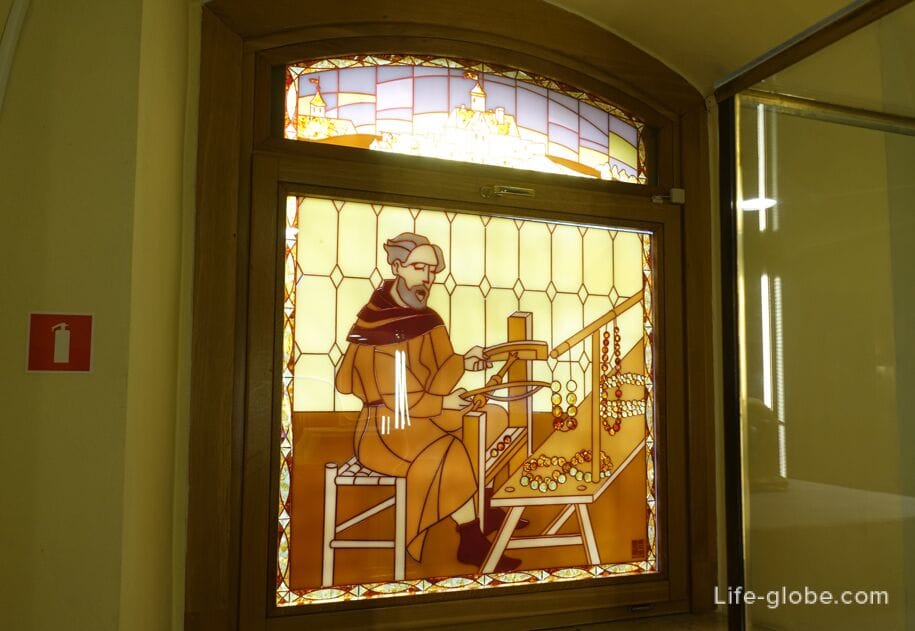
The "Exhibit of the Month" from the museum's fund is exhibited monthly in this hall of the Amber Museum.
The cycle of exhibitions of one exhibit is an additional means to present the extensive collection of the Kaliningrad Amber Museum, which includes about 16 thousand items of storage.
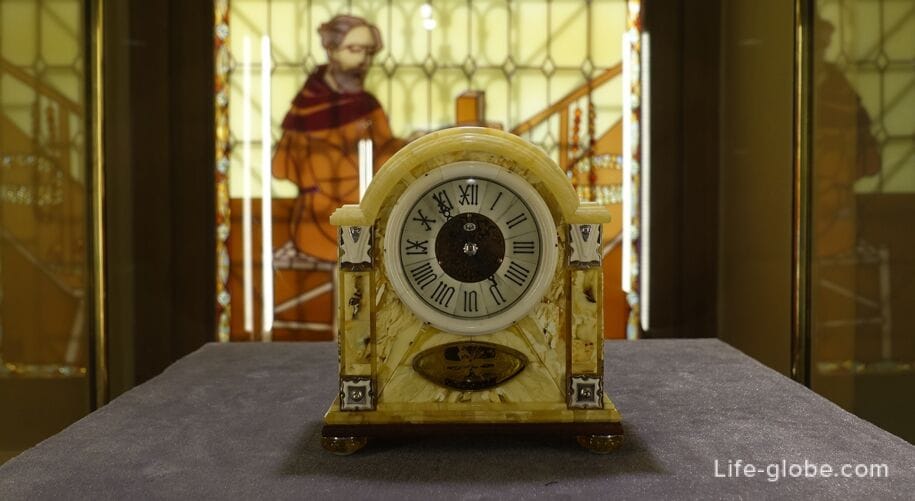
The second hall of the museum is located on the ground floor. Temporary exhibitions are located here. The deadline for the presentation of exhibitions depends on each specific exhibition, on average - 1 month, but it also happened that at the request of visitors, the exhibition was in the museum for a year.
We got to the exhibition of costume and accessories by Julie Mares (Albertville, France) - "Podium".
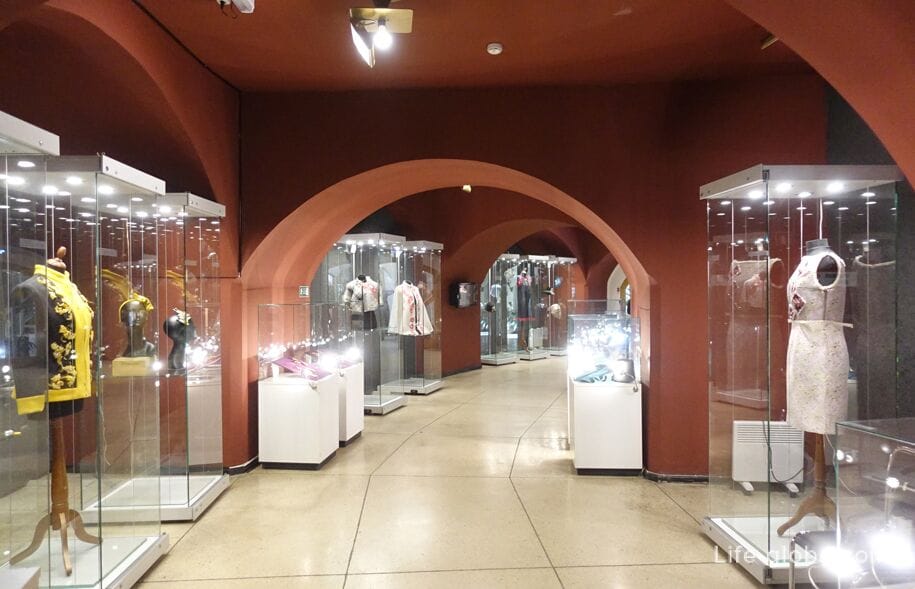
The third hall of the Amber Museum is a temporary exhibition hall, located in the basement of the Don Tower. The entrance is from the second hall.
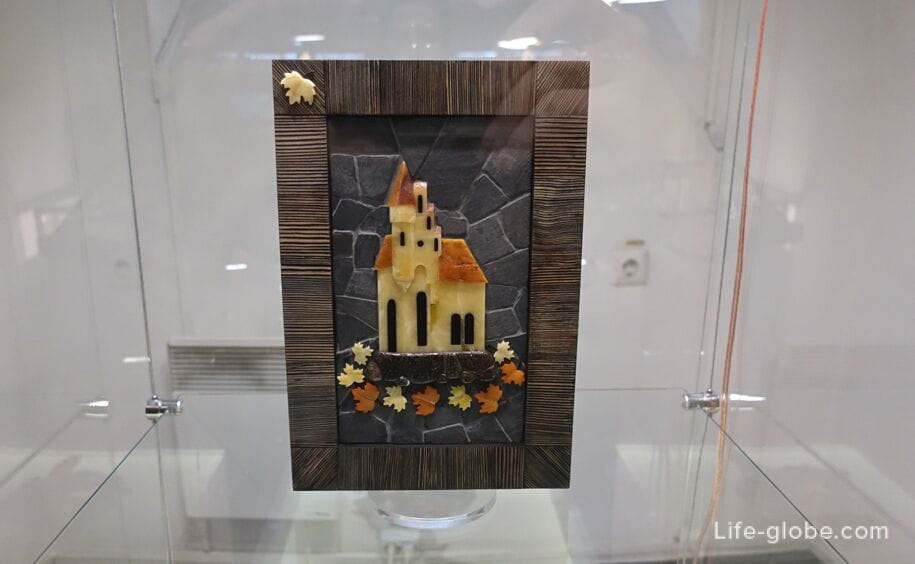
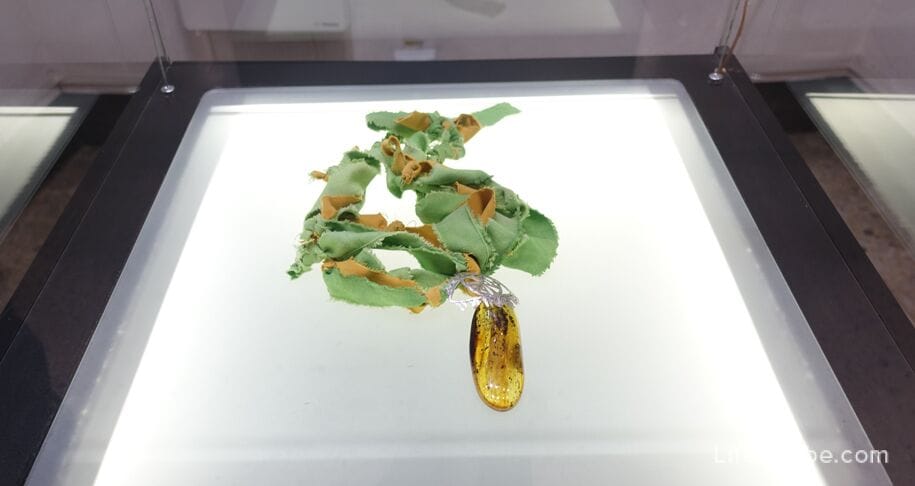
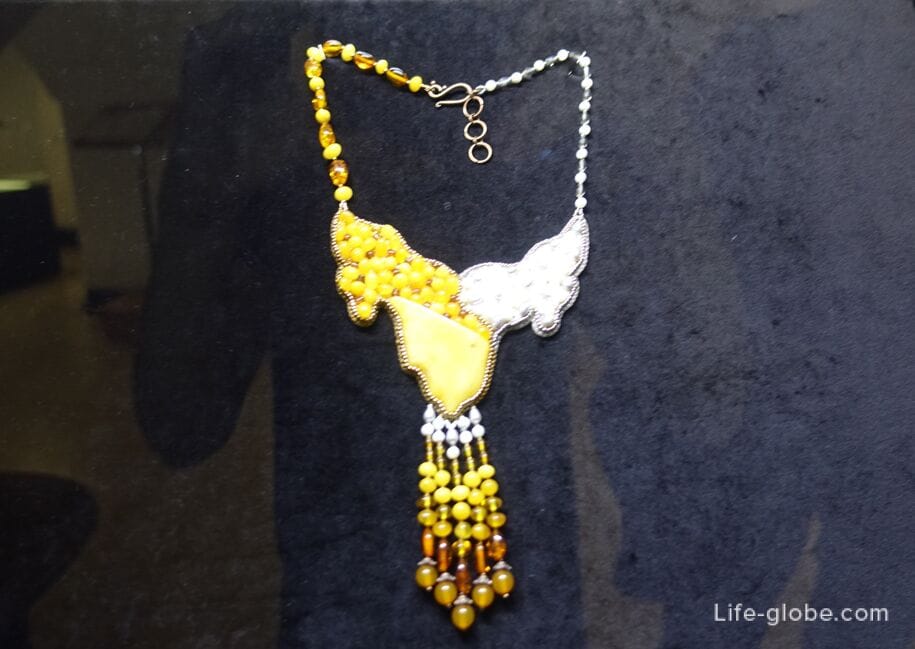
In the hall on a permanent basis are: a souvenir shop; a machine for processing and grinding amber, made from an old sewing machine, behind which everyone can feel like a master of amber; a container with sand, in which everyone can also try to find amber - all the finds remain with the seeker.
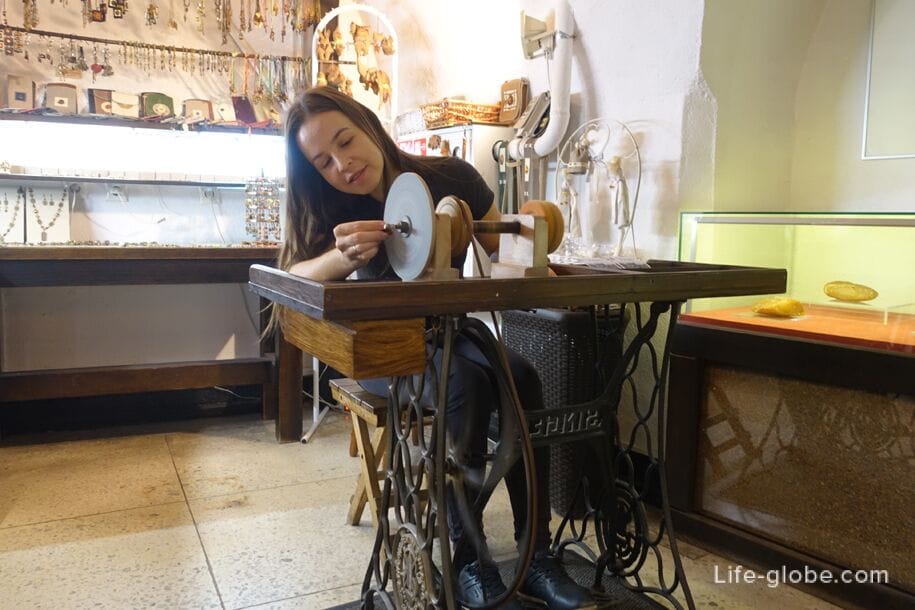

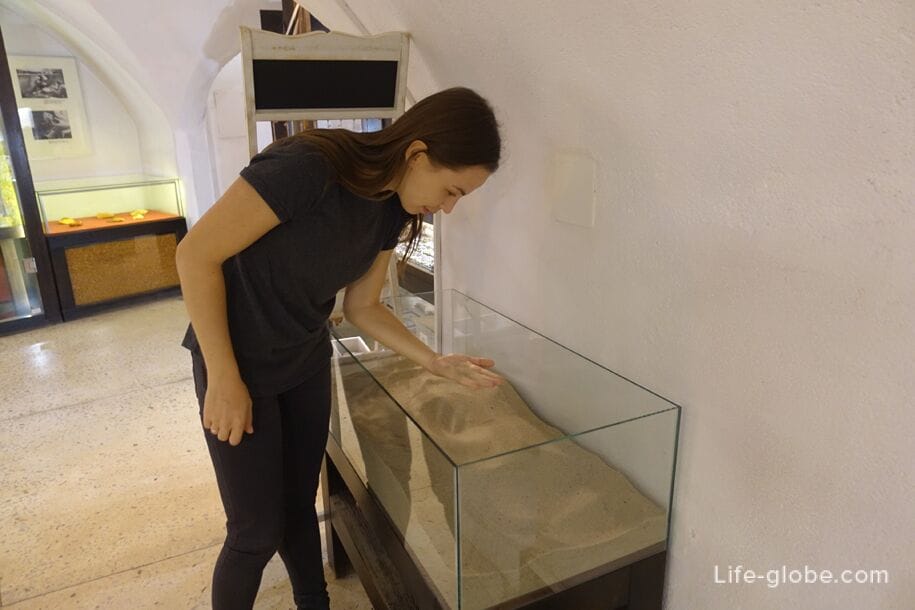
Entrance from the first floor.
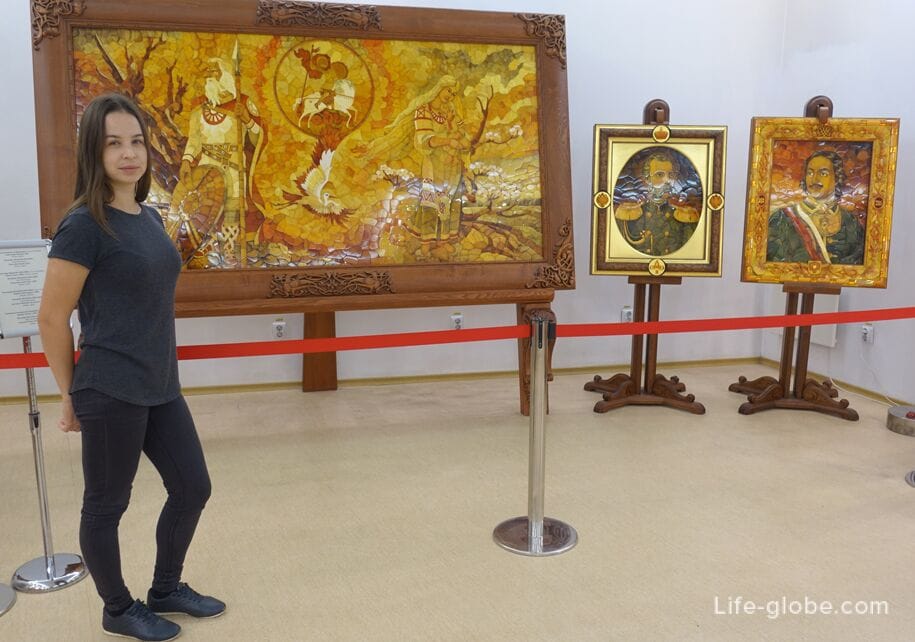
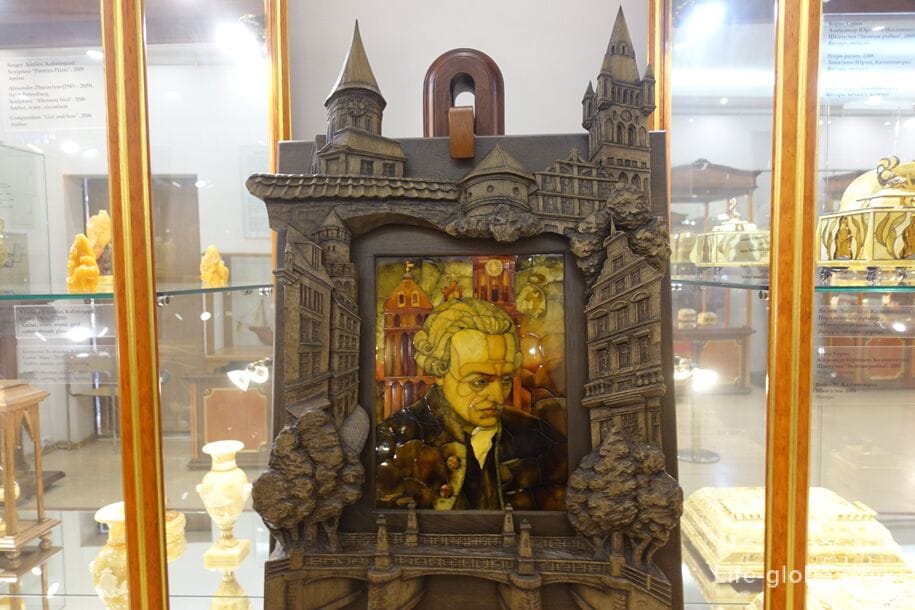

Exhibit Caravel "Santa Maria", 2010, amber, wood. Master Sergey Starovoitov, Kaliningrad.
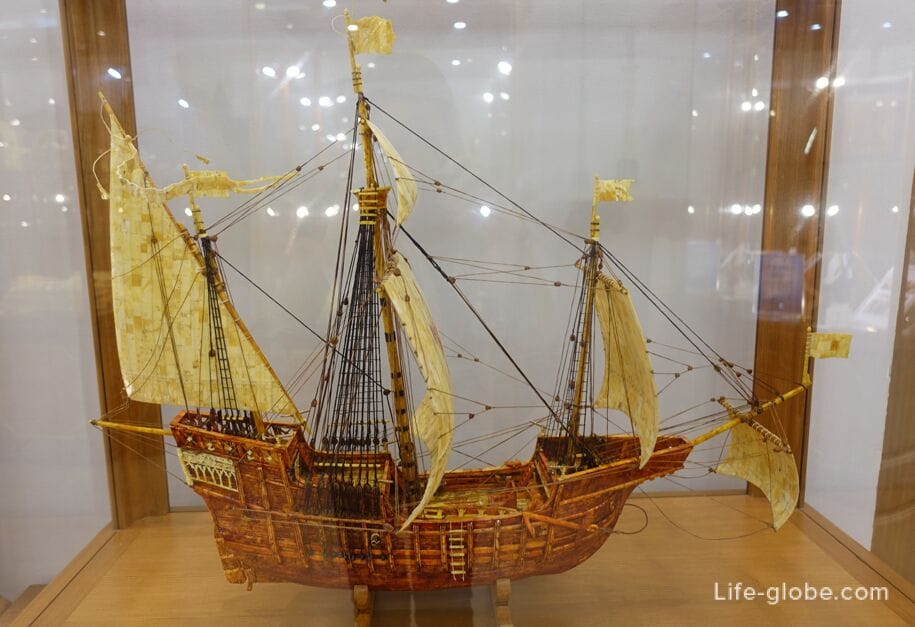
Cuckoo clock, 2010, amber, gold, silver, clockwork, wood. The clock is active, as is the radio presented in this hall. Masters Konstantin and Natalia Domichkovsky, Kaliningrad.

Composition "Orchestra", 2009, amber, bone. Master Andrey Kavetsky, Kaliningrad.
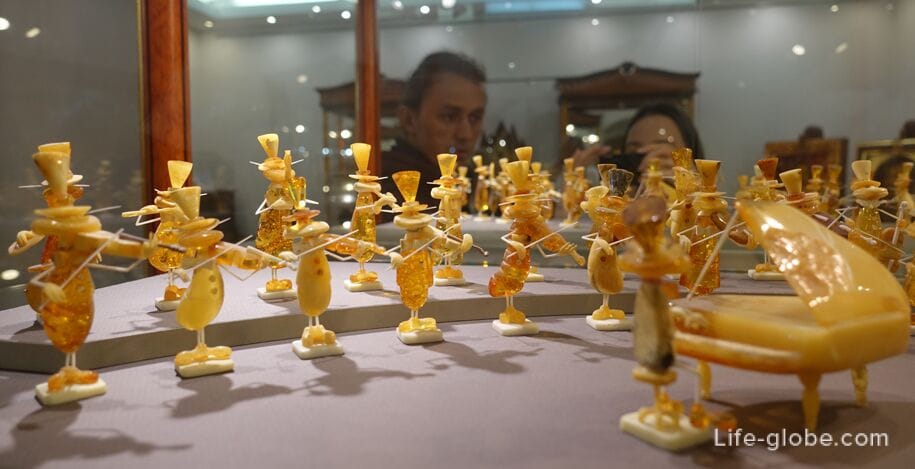
Piano. Germany 1921. A gift from the Antonov family.
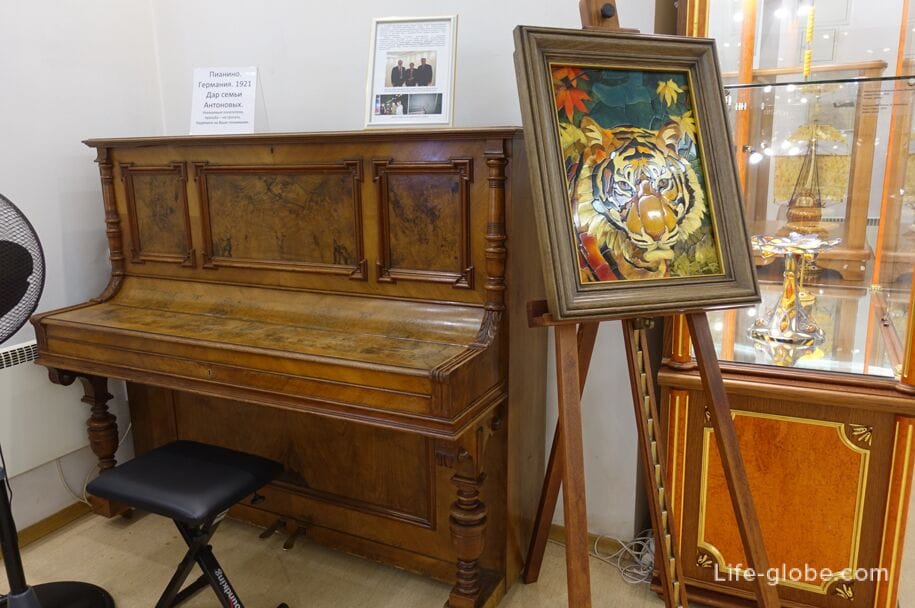
About ten years ago, a sculpture for a fountain made by Robert Derbentsev appeared in the courtyard.

Sculpture "Cormorant", 2010, steel, forging

Sculpture "Miracle Fish", made during the Second All-Russian plein air on artistic metalworking, September 12-14, 2015, steel, forging.
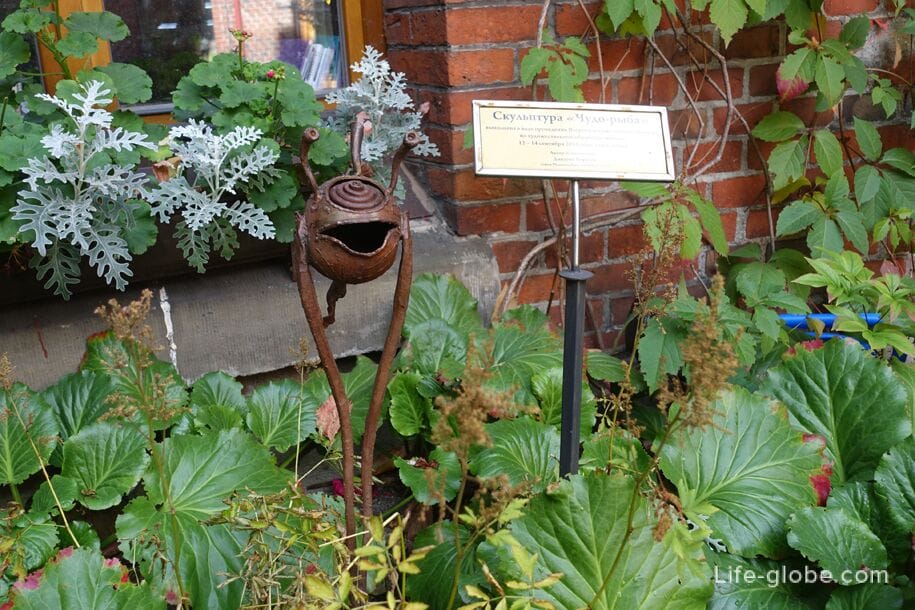
In the Amber Museum, near the exit to the courtyard, you can see a bust of Queen Louise (1776-1810). Copy, 2009.
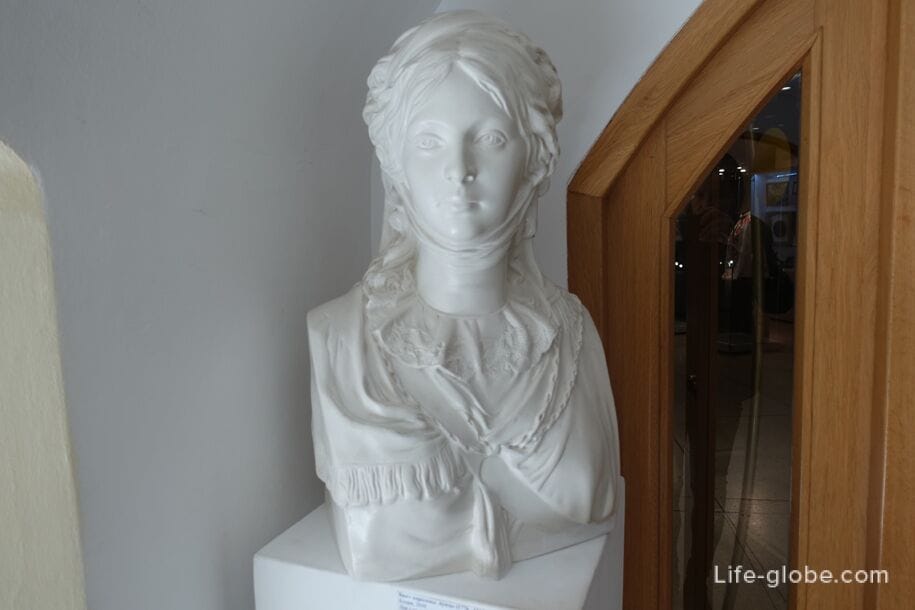
Location of the Amber Museum in Kaliningrad: near Lake Superior, address: Marshal Vasilevsky Square, 1, Kaliningrad.
The distance from the center of Kaliningrad, which is conventionally considered Victory Square, is about 1.5 km. You can walk for 20-25 minutes.
Visit to the Amber Museum in Kaliningrad: near the exhibits of the museum there are info signs, you can additionally purchase an audio guide. You can find out the opening hours of the museum, the time of excursions and the cost of tickets on the official website of the Amber Museum. Tickets can be purchased at the museum's ticket offices.
Official website of the Amber Museum in Kaliningrad: ambermuseum
Upper Lake andThe lower lake is a favorite place for walking and recreation among locals and visitors of the city.
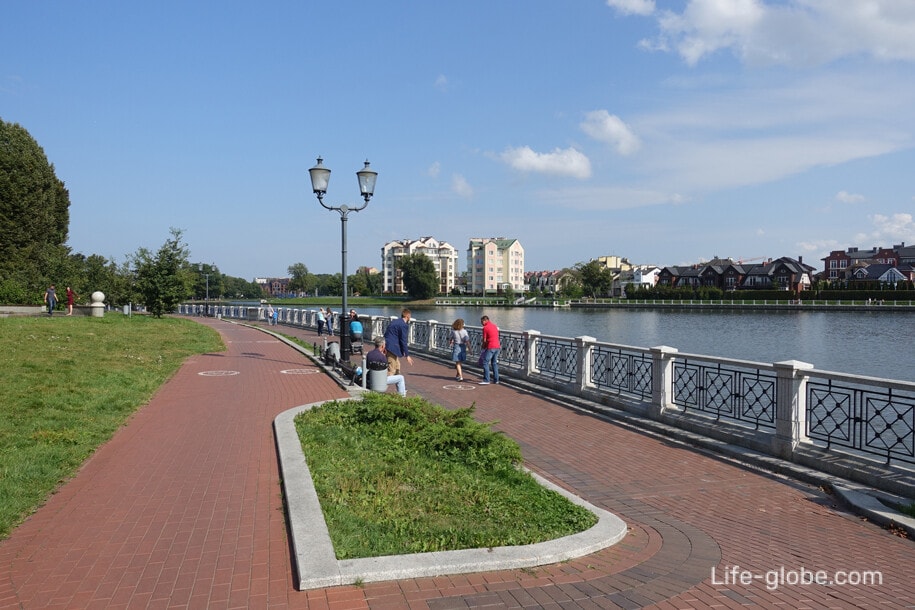
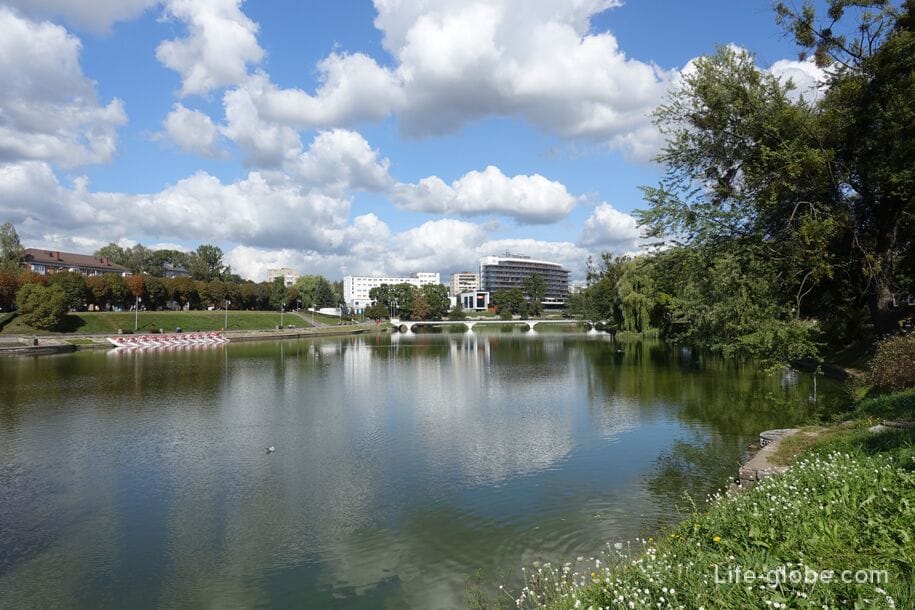
The Wrangel Tower is a fortification built in Konigsberg.
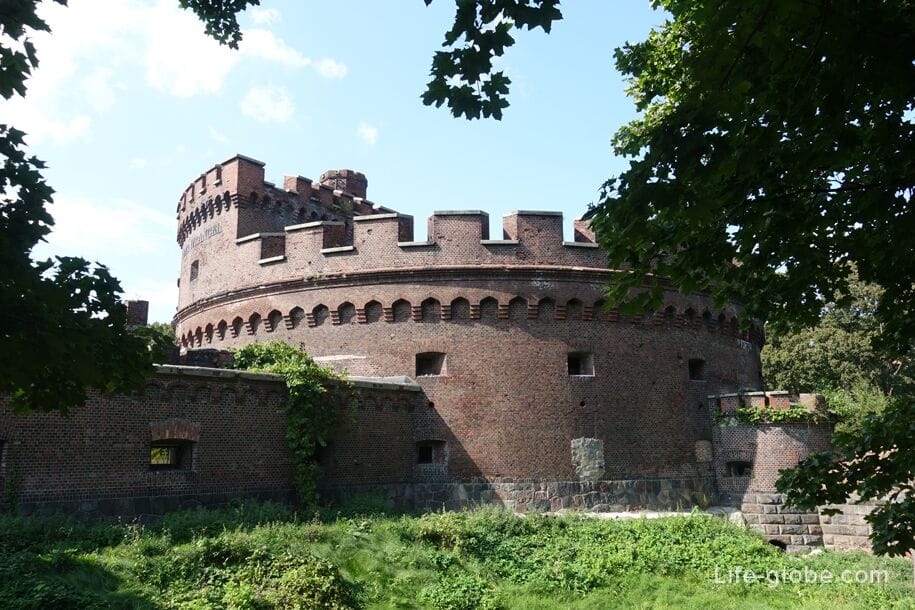
Maraunenhof was once an old German district, where the houses of architecture of those times are still preserved.
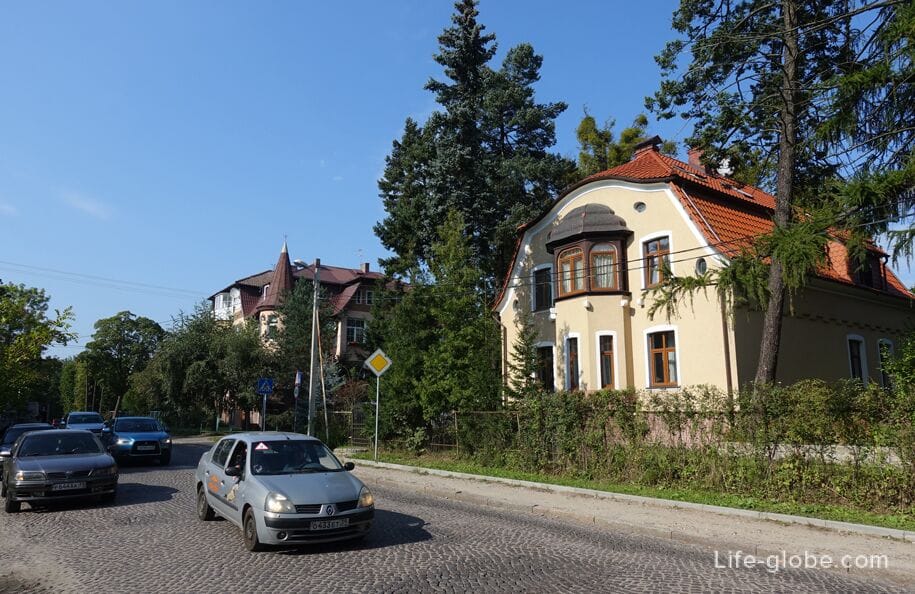
You can visit the Maraunenhof area on your own or with excursions from a Kaliningrad guide:
Yunost Park is one of the most popular city parks in Kaliningrad.
